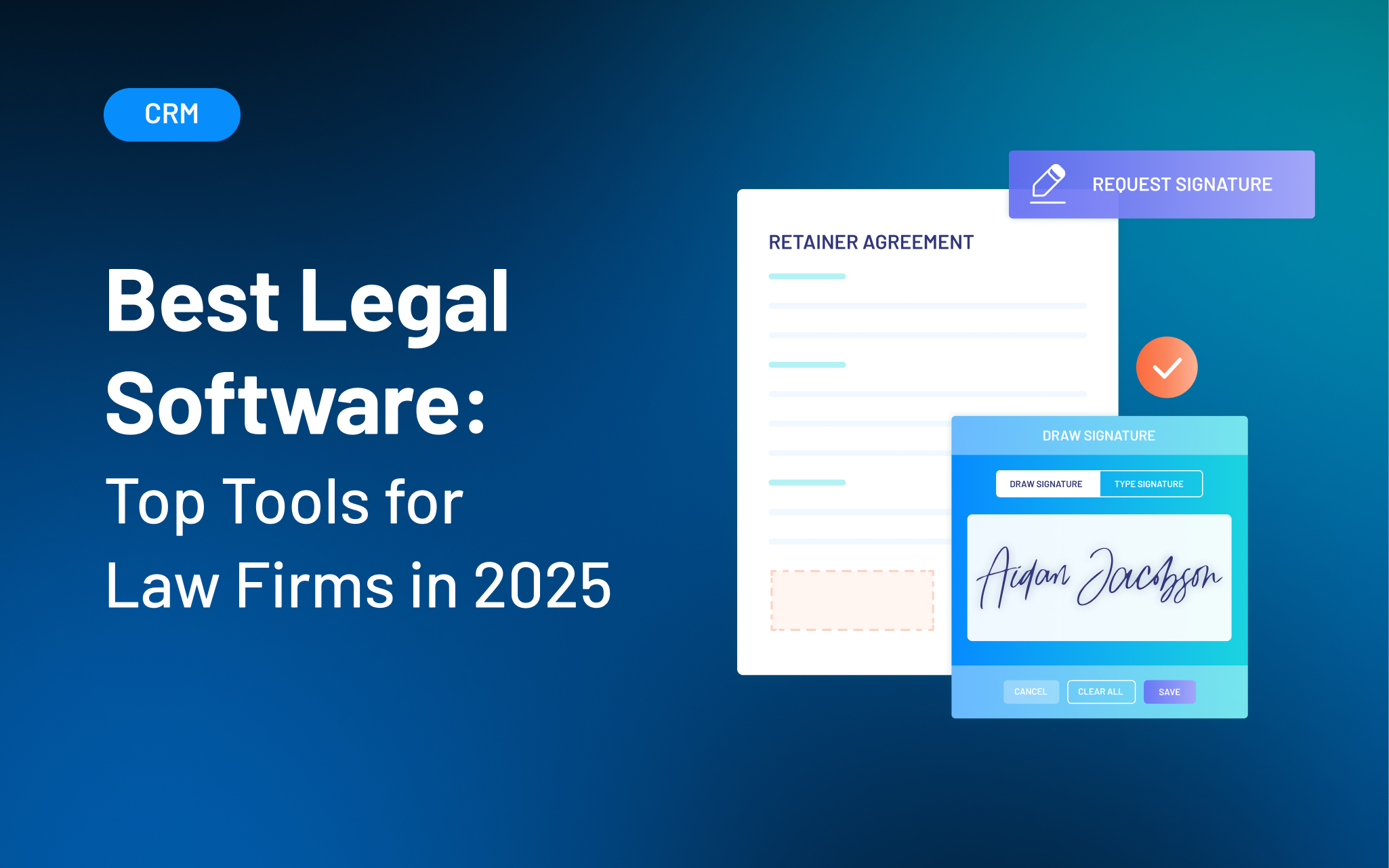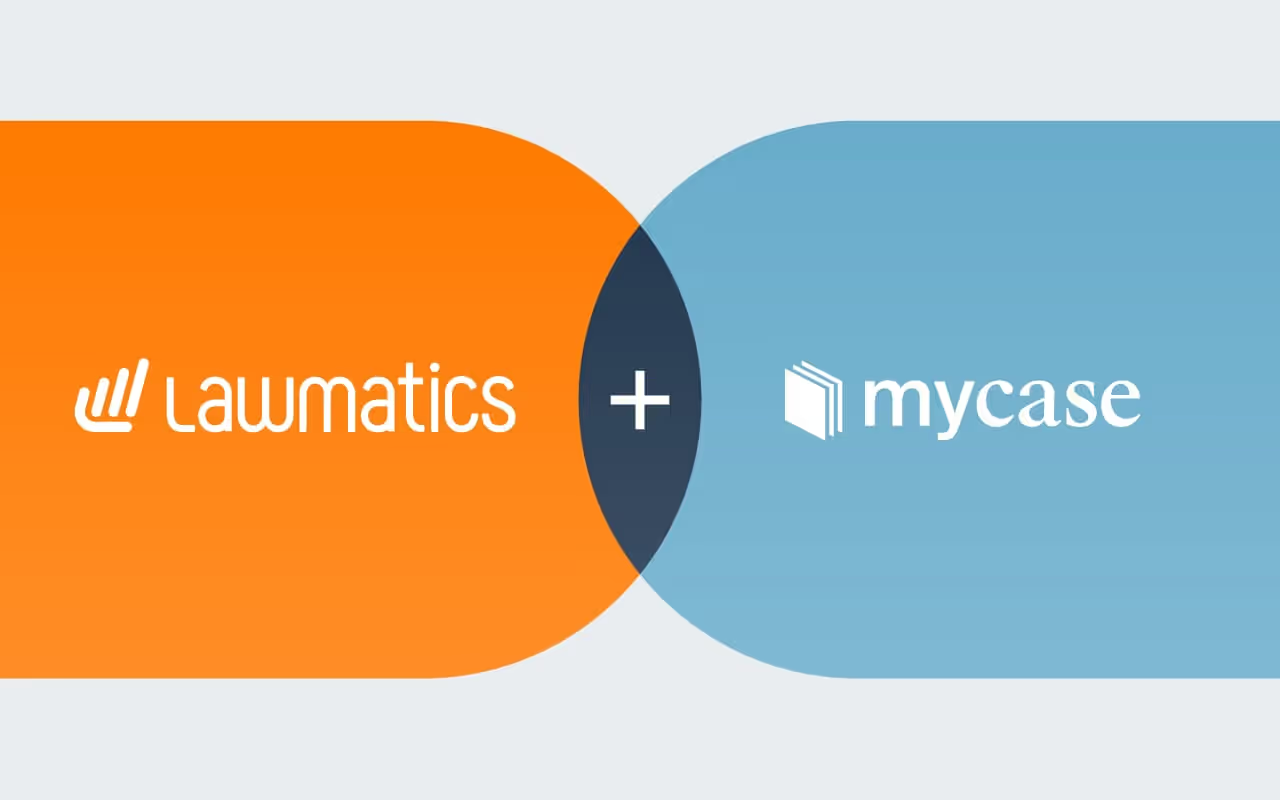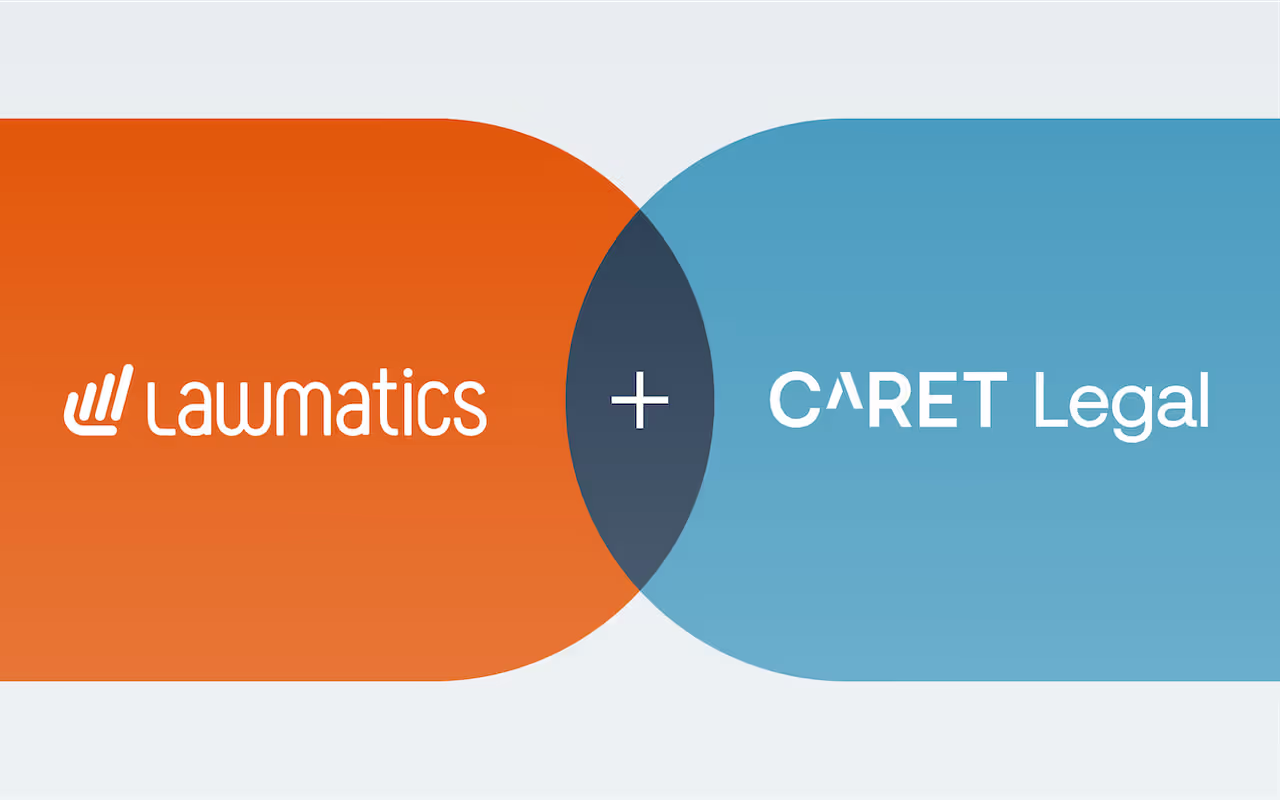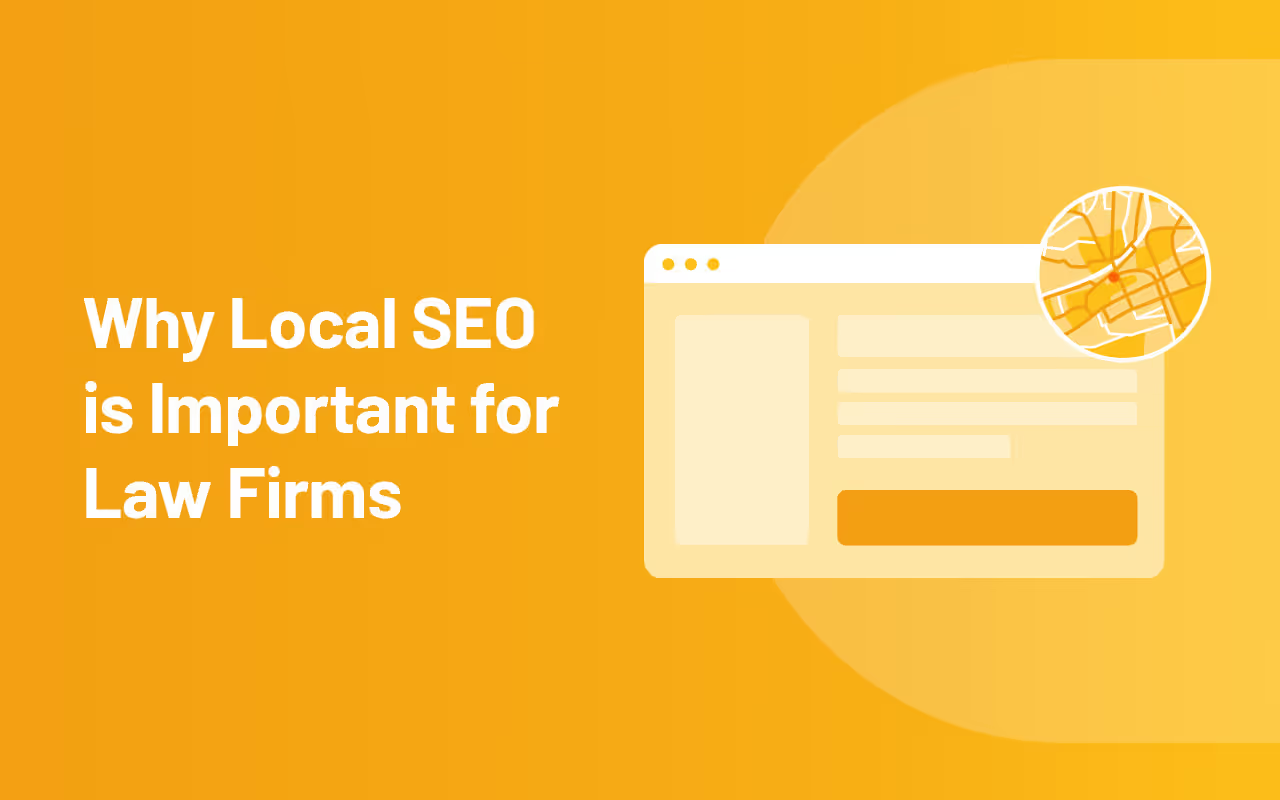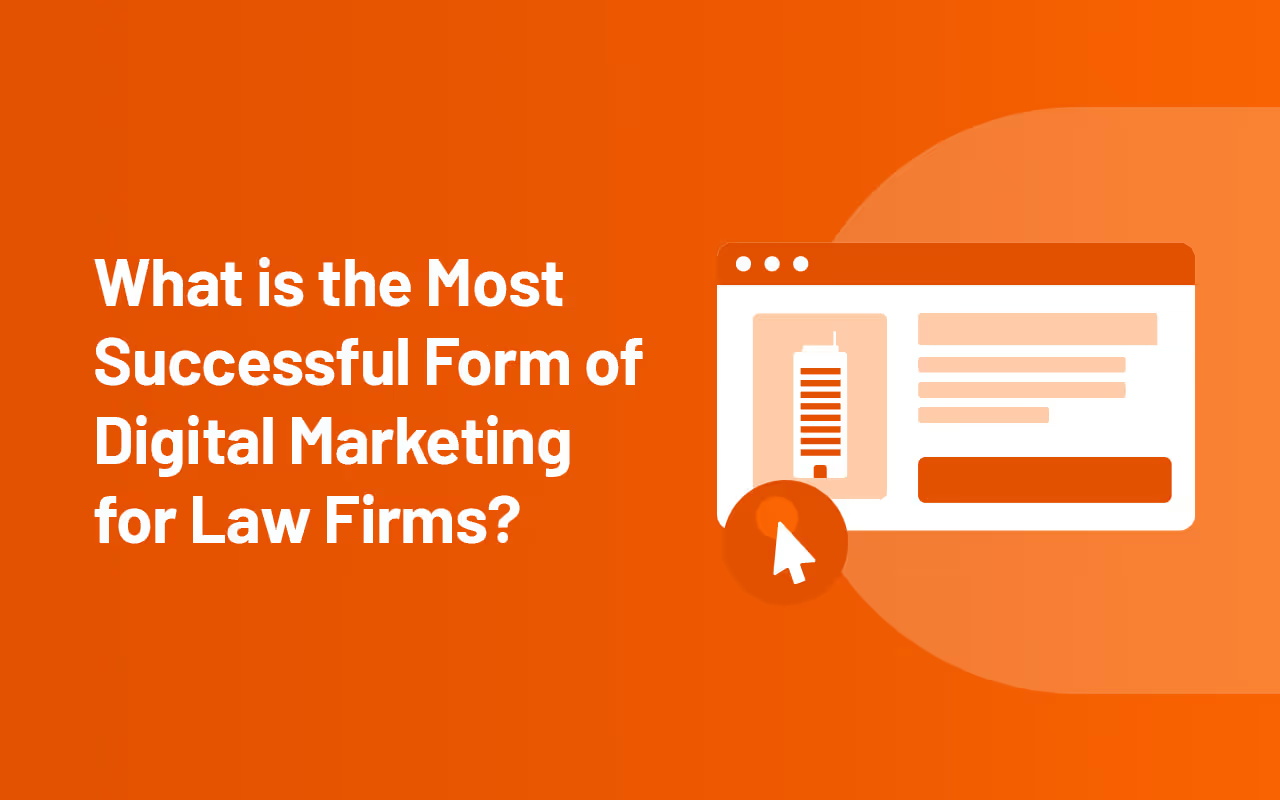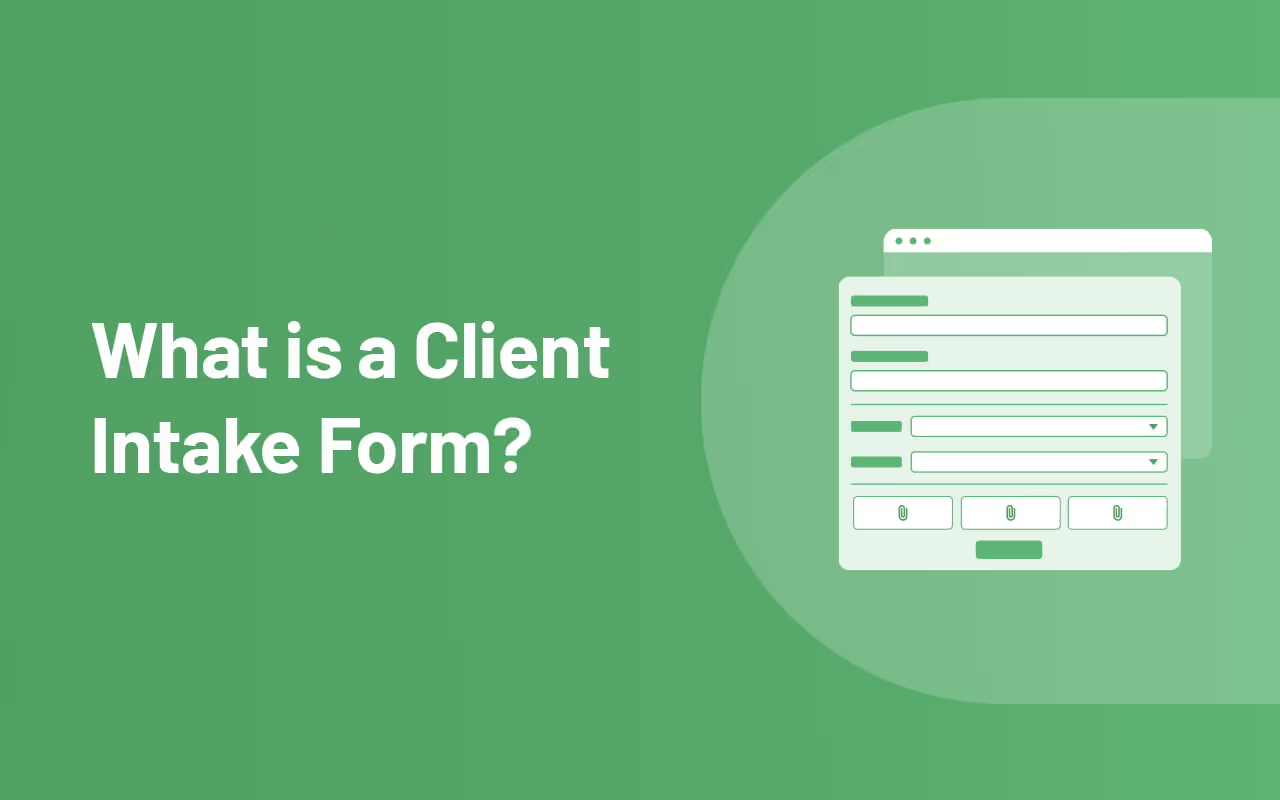CRM
As we head toward the end of the year, our team revisited the most meaningful product updates of 2025 and how they’re reshaping the way firms work. All year long, our product work has centered on the same core goal: removing the obstacles that slow firms down. That’s meant bringing key information to the surface when teams need it, cutting out friction in the client journey, and giving staff clearer ways to build and maintain their processes across the platform.
Time stamps of key takeaways
8:15 – New, intuitive navigation
Devon walks through the redesigned navigation, which brings the most-used areas — like Matters, Pipeline, Calendar, Tasks, and Automations — into a cleaner, left-hand layout for quicker access. Reminders, emails, and other tools that had previously been scattered across the app now live in central, easy-to-find locations. The goal is simple: fewer clicks, clearer groupings, and a workspace that reflects how firms actually move through intake.
26:20 – Get key info faster with MMS
The team shows how firms can now receive MMS messages directly into Lawmatics, allowing clients to text photos or documents straight into their matter. It’s especially useful for practices like personal injury, where images of an accident or ID documents are often needed quickly.
31:18 – Manage your emails in one place
Email tools have been fully centralized, replacing the old model where templates lived in different corners of the app. Everything — from document send templates to automation emails — can now be created, edited, and organized in one place. Folders help firms manage growing libraries of emails, and each template can be applied across multiple documents without duplicate versions.
36:55 – Build and maintain automations with less effort
Devon and Clare highlight the refreshed automation experience, which makes appointment-based and date-based workflows easier to find, build, and understand. Relative timing is now built directly into each automation, and shared entry rules help firms avoid recreating the same logic dozens of times. Automation builds can also now be grouped in folders, similar to how you organize your email library.
45:18 – Additional highlights
The session closes with a handful of smaller but long-requested additions, including improvements to round-robin scheduling, password-protected forms, Message Center filters, auto-pay for billing, and color-coded appointment types to make dense calendars easier to read.
Webinar slide deck
This guide highlights the best vendors in the four main categories of law firm software: customer relationship management (CRM), case management, legal document management, and time-tracking and billing solutions. Lawmatics tops our roundup for its extensive integrations, automation tools, and customizable features that help you explore new leads and strengthen existing client relationships.
Running a successful law firm means juggling countless tasks beyond courtroom appearances, from client intake and case prep to time-tracking and billing. Add marketing your services between meetings and court dates, and it's easy to feel overwhelmed, especially without dedicated administrative support.
The right legal software makes all the difference. According to 2025 Harvard Law School research, legal technology (particularly AI-powered tools) can boost lawyer productivity up to 100 times. This not only leads to better service quality but to a stronger reputation and, ultimately, increased revenue.
But the best legal software for your firm isn't necessarily what your competitor uses. This guide ranks top vendors in each category — CRM, case management, document management, and billing and time-tracking — so you can find the perfect fit.
What Is Legal Software?
Legal software is a broad category of tech applications designed to streamline the day-to-day operations of law firms. It ranges from electronic client intake forms that speed up prescreening to matter management tools that provide a comprehensive view of all your cases.
The main types of software for lawyers include:
- Customer relationship management (CRM): Sources, onboards, and maintains client relationships through email campaigns, drip marketing, and client portals.
- Intake management: Creates custom electronic intake forms based on your specialty and schedules new client appointments.
- Practice (case) management: Handles internal administrative tasks like bookkeeping, document management, deadline tracking, scheduling, and matter monitoring.
- Document management: Creates, organizes, and shares documents securely while complying with regulations like HIPAA.
- Billing management: Generates, sends, and streamlines client invoices, expenses, and payments, including trust account management.
- Time-tracking: Records billable and non-billable hours across multiple projects with easy-access timers on any device.
Many legal platforms integrate with third-party tools, like project management, lead generation, calendar, video conferencing, and accounting software, to create a seamless tech ecosystem.
Legal software can also be as comprehensive or specialized as you need, from all-in-one solutions to standalone products that address specific needs.
Learn more about legal software programs and the difference between legal CRMs and practice management with CRM for Law Firms: Complete Guide.
How to Choose the Best Legal Software
Beyond features, evaluate these factors when selecting the best legal software to fit your needs.
Ease of use & adoption
If finding the settings menu takes 10 minutes, imagine your staff's frustration. Choose platforms with intuitive, modern designs that your team can navigate easily. Familiar interfaces with customization options reduce training time and encourage firm-wide adoption.
Integrations & compatibility
When legal software integrates with the other tech tools you use every day, productivity soars. You and your staff avoid the cognitive strain of constantly switching between applications or the dreaded “toggle tax.”
Look for solutions that already have native integrations with your current business applications. At a minimum, your choice should connect with your CRM, billing, and case management systems.
Lawmatics integrations, for example, include Clio, MyCase, and PracticePanther. This allows you to unite CRM and case management without duplicate data entry.
Security & compliance
Client confidentiality is paramount. With the shift to cloud-based legal software solutions, data breach risks are a serious threat.
Evaluate legal platforms for their data encryption, audit trails, and secure storage capabilities. Verify they support two-factor authentication, role-based permissions, and access controls.
And, ensure they comply with SOC 2 Type 2 or ISO 27001 standards, plus laws like Health Insurance Portability and Accountability Act (HIPAA) and the California Consumer Privacy Act (CCPA).
Scalability & cost
Your ideal legal software should meet current needs while supporting future growth.
This might include additional customization options, analytics, reports, automations, AI tools, integrations, and API access as you evolve. Many platforms offer tiered pricing that unlocks features when the time is right.
You’ll also need to consider your budget carefully. Most cloud-based platforms charge monthly subscriptions based on firm size, user count, and feature tier. Watch for hidden costs like storage, support, implementation, and data migration fees.
Best Legal CRM & Client Intake Software
CRM and client intake software are critical for firm growth. Some features overlap with practice management tools, like calendaring and contact management. Meanwhile, CRM adds marketing and nurturing capabilities to keep prospects and former clients engaged.
Lawmatics
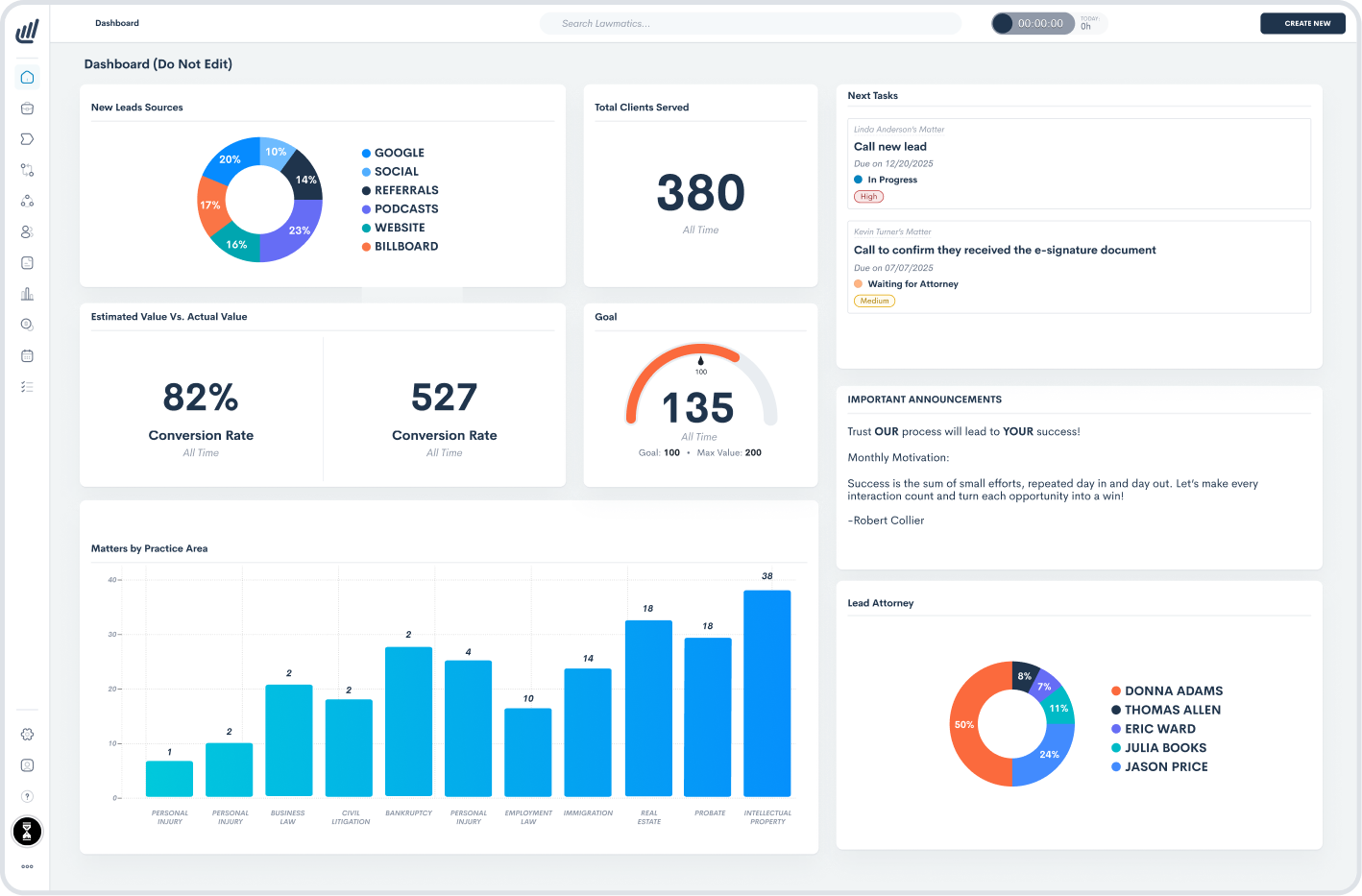
Lawmatics is a legal software platform with client intake, CRM, and data analytics capabilities, with an add-on for time tracking and billing. In particular, Lawmatics CRM handles the time-consuming work of organizing, scheduling, and following up with leads — tasks that often pull attorneys away from case preparation.
Lawmatics leads the pack with its powerful client pipeline automations, which sort and progress prospects across stages with minimal direct involvement. Plus, its AI-powered email drafting and SMS/MMS capabilities speed up client communication to enhance their overall experience.
Features:
- Client intake and pipeline automation
- Custom form builder
- Conflict checking
- Appointment booking, including client self-scheduling
- Email drip marketing campaigns
- E-signatures
- Client portals
- AI email drafting
- Custom analytics and reporting dashboards
- Optional time-tracking and billing add-on
Pricing: Contact sales for a quote. Three tiers are available (Essential, Premium, Enterprise) with a three-user minimum. Time & Billing available as an add-on.
Key differentiator: Native integrations with multiple vendors, including Clio, 8am MyCase, Smokeball, and QuickBooks.
Captorra
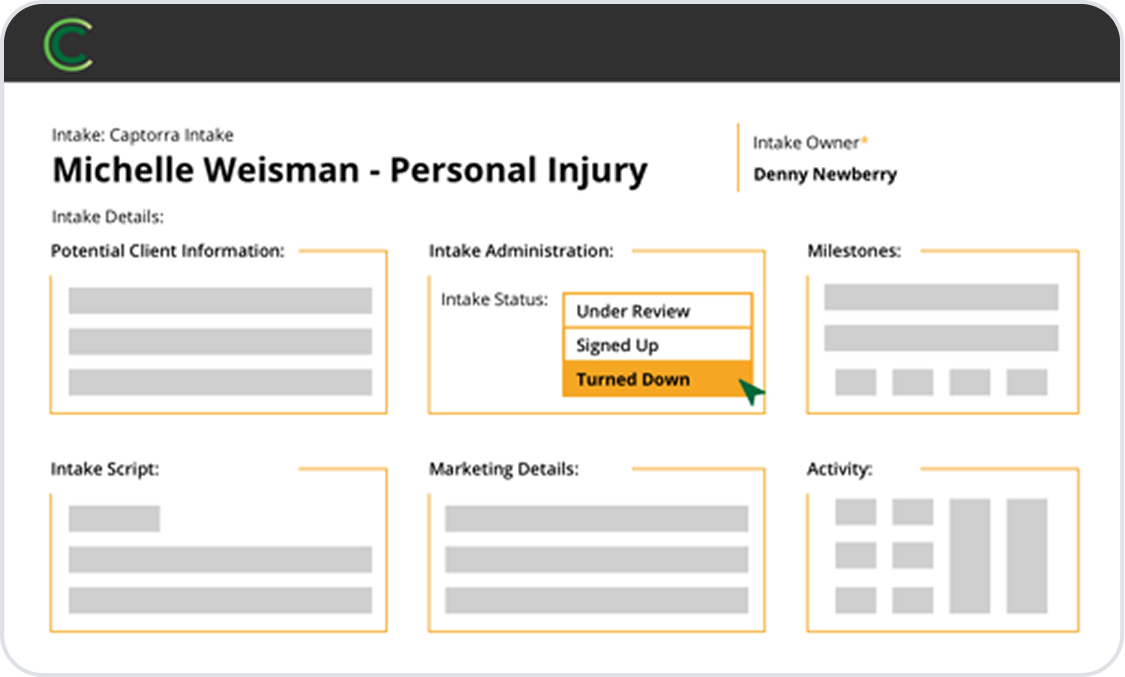
Captorra offers both lead and case management to support the whole client life cycle. Its intake management is particularly strong. It lets you create custom scripts for your intake specialists and paralegals.
You can even build automated turn-down processes that politely decline unqualified leads while maintaining positive relationships.
Features:
- Lead tracking
- Custom workflows
- E-signatures
- Referral management to determine strong referral partners
- Integrations with live chat and call center providers
Pricing: Contact sales for a quote.
Key differentiator: Automated prospect follow-up emails that keep leads warm and encourage sign-up.
Clio Grow

Clio Grow, formerly known as Lexicata, is a client intake solution purpose-built for law firms. It centralizes lead capture, intake form completion, and client onboarding within a single interface. Clio Grow includes charts that highlight lead sources and conversion trends over time, along with active intake workflows and upcoming follow-ups.
Integrating directly with Clio Manage, Clio Grow connects marketing, intake, and case management to create a seamless client experience from first contact to active representation. Clio Grow’s CRM features allow firms to automate reminders, track lead activity, and personalize follow-ups through email, text, or website form.
Features:
- Custom intake forms
- E-signatures
- Automated workflows and reminders
- Email and calendar sync
- Lead source tracking and reporting
Pricing:
7-day free trial. Afterward (billed annually):
- Basic: $49 per user per month
- Advanced: $69 per user per month
- Suite: $89 per user per month (includes Clio Manage integration)
Best Legal Case Management Software
Case, or practice, management software is essential for your daily case handling. Below are some of the top vendors.
Remember: Case management software boosts productivity, but you'll also need a CRM, like Lawmatics, to source, maintain, and engage with current and former clients. This ensures great experiences from intake to case closure, which strengthens your reputation and drives growth.
8am MyCase
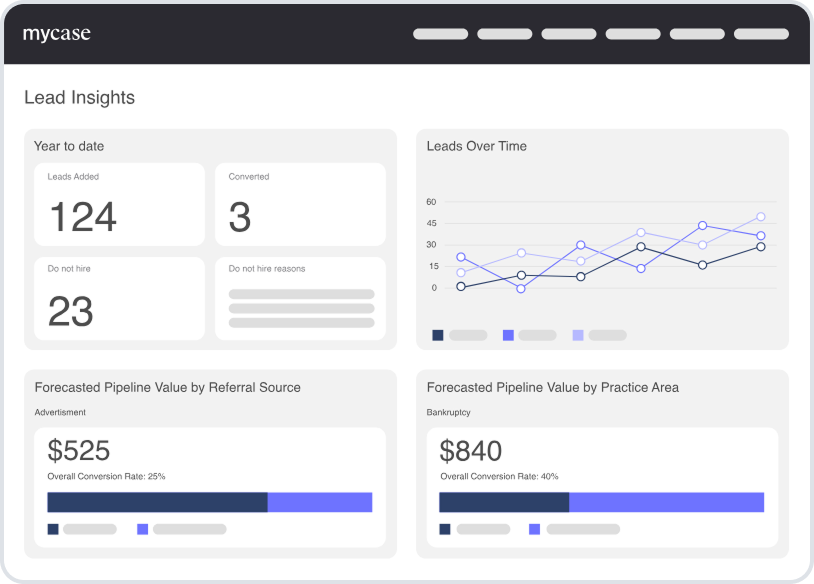
8am MyCase is a legal platform offering native functionality for case management, communications, intake, billing, and time-tracking. Rather than separate products, each subscription tier provides access to some of these capabilities, with more advanced versions unlocked at higher tiers.
MyCase's CRM features allow audience segmentation and communication through email, text, and your firm’s website.
Features:
- Client intake
- E-signatures
- Document automation
- Mobile app
- Workflow automation
Pricing:
10-day free trial. Afterward (billed annually):
- Basic: $39 per user per month
- Pro: $89 per user per month
- Advanced: $109 per user per month
- Add-ons: LawPay Payments, MyCase Accounting, and Website
Key differentiator: Create a law firm website with embedded intake forms and client portal connections.
Clio Manage
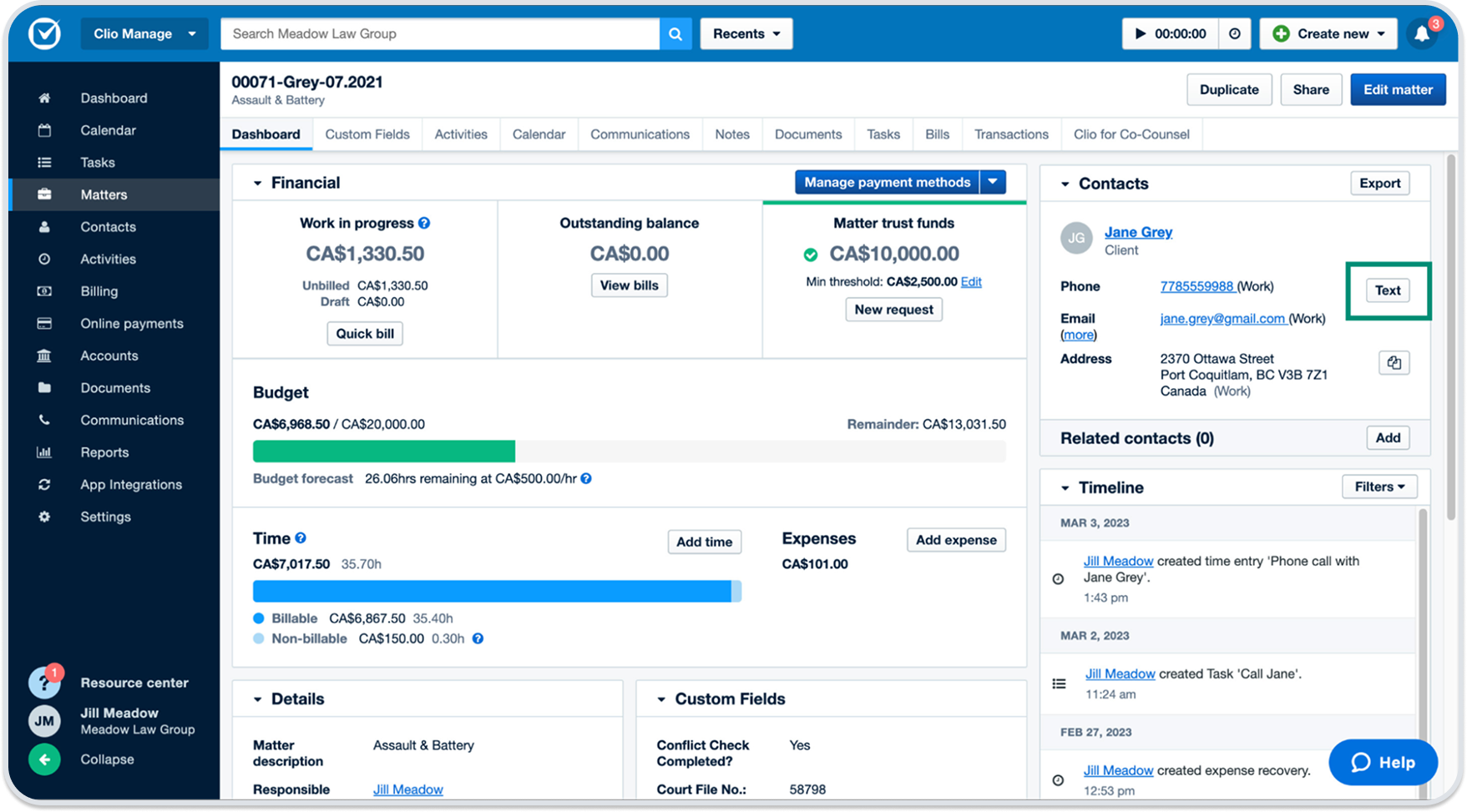
Clio is one of the biggest names in legal software, offering CRM and case management alongside advanced document, time-tracking, and financial management features. Clio Manage is its case management product. It includes calendaring, task, and contact management tools for internal operations.
Clio Manage also provides detailed reports and analytics, including utilization, realization, and collection rates, to help you understand your firm’s overall performance.
Features:
- All-in-one legal software suite
- Custom report builder
- Project-management collaboration tools
- Client scheduler
- Legal aid tools
- 250+ integration partners
Pricing:
7-day free trial (up to Advanced tier). Afterward (billed annually):
- EasyStart: $49 per user per month
- Essentials: $89 per user per month
- Advanced: $119 per user per month
- Complete: $149 per user per month
- Add-ons (Essentials tier and up): Advanced Document Automation, Clio Duo, Clio Grow, Clio Accounting, Personal Injury, and HIPAA Liability Protection.
Key differentiator: Specialty-specific tools like medical management and settlement features for personal injury practices.
PracticePanther

PracticePanther is a powerful practice management platform with calendaring, document management, and task collaboration features.
Its intuitive interface makes it easy to navigate, even for nontech-savvy staff. Integration with platforms like Zapier extends its functionality, letting attorneys and staff boost productivity without leaving the app.
Features:
- Case tracking
- Billing
- Workflow automations
- E-payments
- Unlimited data storage
Pricing:
7-day free trial. Afterward (billed annually):
- Solo: $49 per user per month
- Essential: $69 per user per month
- Business: $89 per user per month
Key differentiator: Military-grade 256-bit data encryption for secure firm and client information.
Smokeball
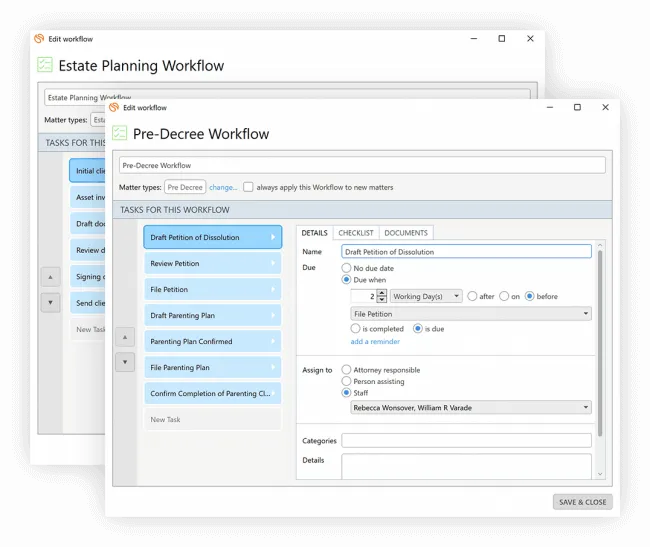
Smokeball is a legal software that, unlike Clio and PracticePanther, focuses primarily on case management tools to automate time-consuming administrative tasks. This makes it particularly suited for small-to-midsize law firms moving away from manual processes and spreadsheets.
Beyond workflow automation, Smokeball includes basic billing and time-tracking in all subscription tiers for improved financial visibility and productivity monitoring.
Features:
- Document automation
- Case management
- Built-in productivity tracking
- Free software training and configuration
- Legal drafting
Pricing: Contact sales for a quote. Four tiers are available (Bill, Boost, Grow, and Prosper+). Add-ons like Intake and Archie AI Assistant are available for Boost plans and up.
Key differentiator: AI-powered assistant, Archie, enables email drafting, matter and document summaries, and legal document creation.
Best Legal Document Management Software
Legal document management platforms ensure the organization and security of your firm and client information. At the same time, they help simplify document generation and maintain compliance with data privacy laws.
Lawmatics document automation, for example, auto-generates documents from templates to save time and reduce repetitive drafting.
Explore other top legal document management systems below.
iManage
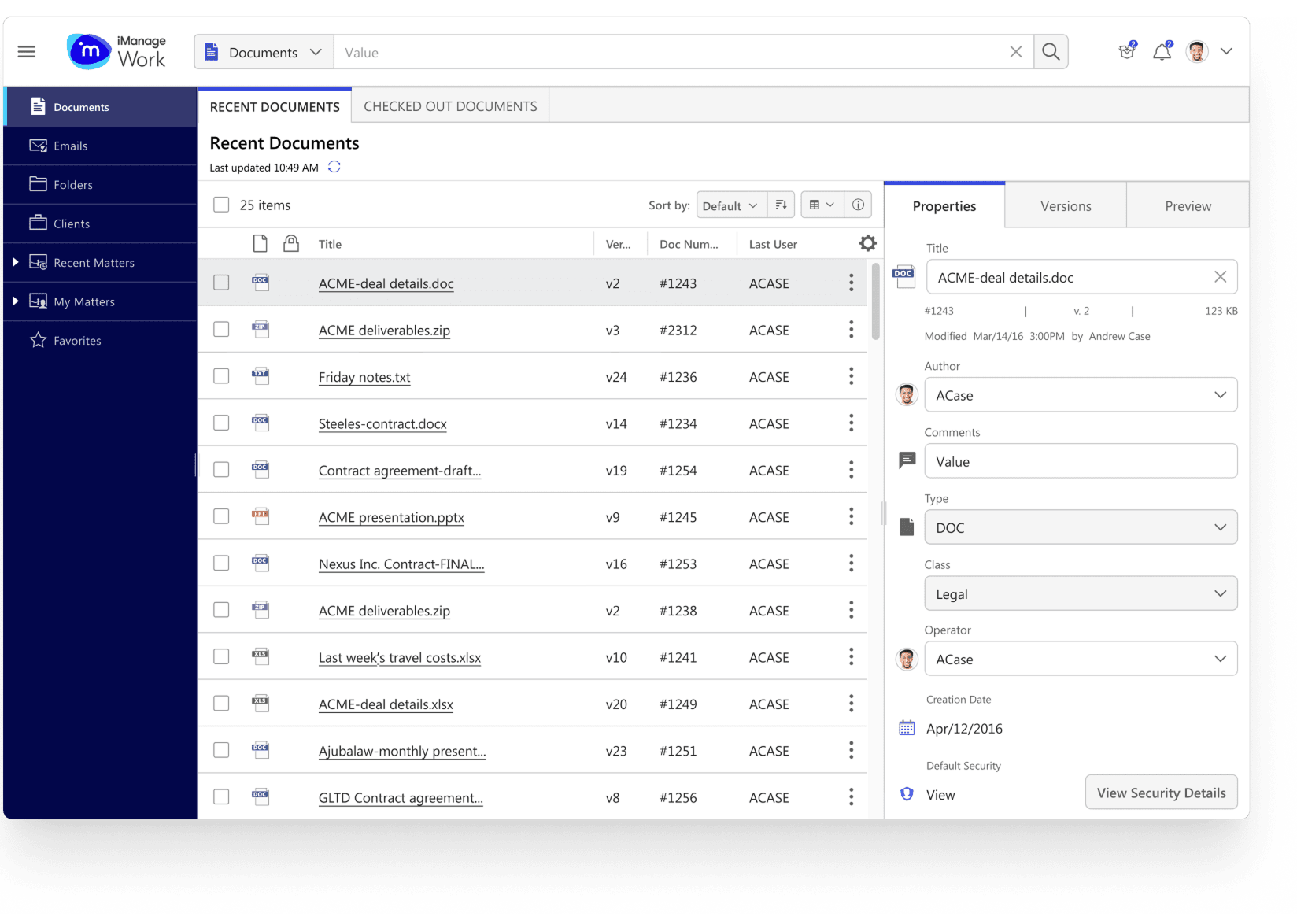
iManage is a document storage, sharing, and team collaboration tool. While not law-firm-specific, its enterprise-grade controls ensure asset protection while eliminating team and data silos.
Features:
- Document and email management controls
- Legal transaction management
- Security and governance protocols, like Threat Manager
Pricing: Contact sales for a quote
Key differentiator: Advanced search capabilities, including natural language searches and conversation with Ask Knowledge, its AI assistant.
NetDocuments
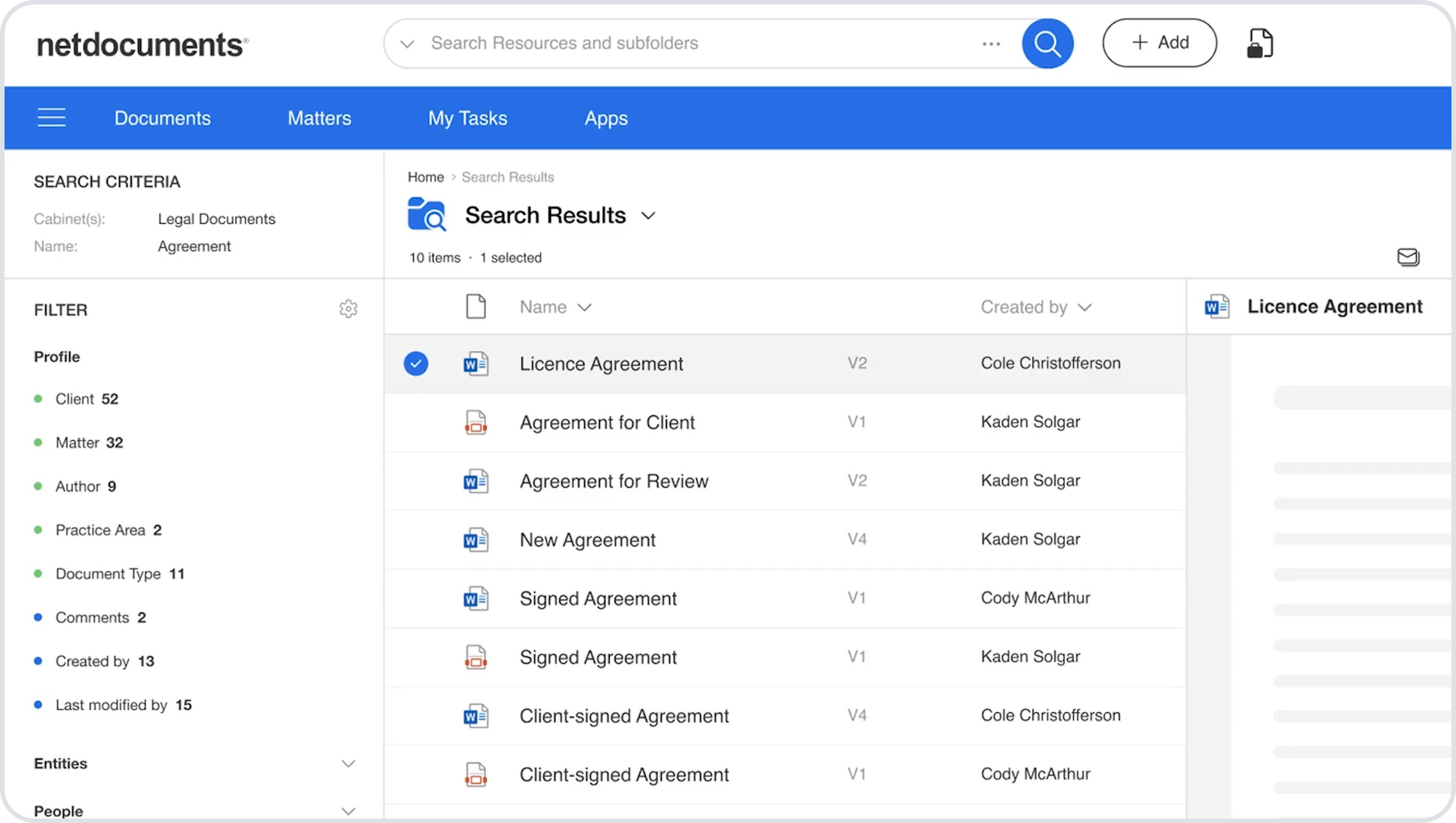
NetDocuments is a document management platform purpose-built for law firms. As such, it designed its tools with the needs of lawyers in mind. This includes search filters for matters and automation workflows for legal document creation, like intake forms and retainer agreements.
Features:
- Legal AI Assistant with agentic AI capabilities
- PatternBuilder for automation and multi-document creation
- Document bundling and delivery
Pricing: Contact sales for a quote.
Key differentiator: Ethical walls and granular access controls that restrict document and workspace access, maintaining client confidentiality.
Clio Docs

As a comprehensive legal platform, Clio includes document management directly within its practice management system. This makes content creation and collaboration seamless. For example, autofilling documents with information stored in Clio Manage.
Features:
- Clio Drive for Windows and Mac
- Integration with other Clio products
- Desktop and mobile support
Pricing: 7-day free trial. Starts at $49 per user per month for document storage and e-signatures. Advanced document automation is an add-on.
Key differentiator: Ability to scan and upload physical documents to move to a completely paperless workspace.
Best Legal Billing & Time-Tracking Software
Billing and time-tracking software is essential for understanding your firm's profitability and growth potential. The right software helps you pinpoint billing bottlenecks, identify lost billable hours, and prevent payment delays.
Lawmatics Legal Billing add-on, for example, lets clients view and pay invoices from their portal, speeding up payment processing.
Check out other great options below.
TimeSolv

TimeSolv is a time and billing platform designed for solo practices or small-to-midsize firms. Its simple design and integrations with accounting tools like QuickBooks, Xero, and AccountEdge encourage adoption while providing a macro view of your firm’s profitability.
Features:
- Trust accounting
- Budgeting
- Offline time tracking
Pricing:
10-day free trial. Afterward (billed annually):
- TimeSolv Pro: $38 per month.
- TimeSolv Legal: $53 per month.
Key differentiator: Outsourced legal bookkeeping services for firms without in-house billing resources.
Bill4Time
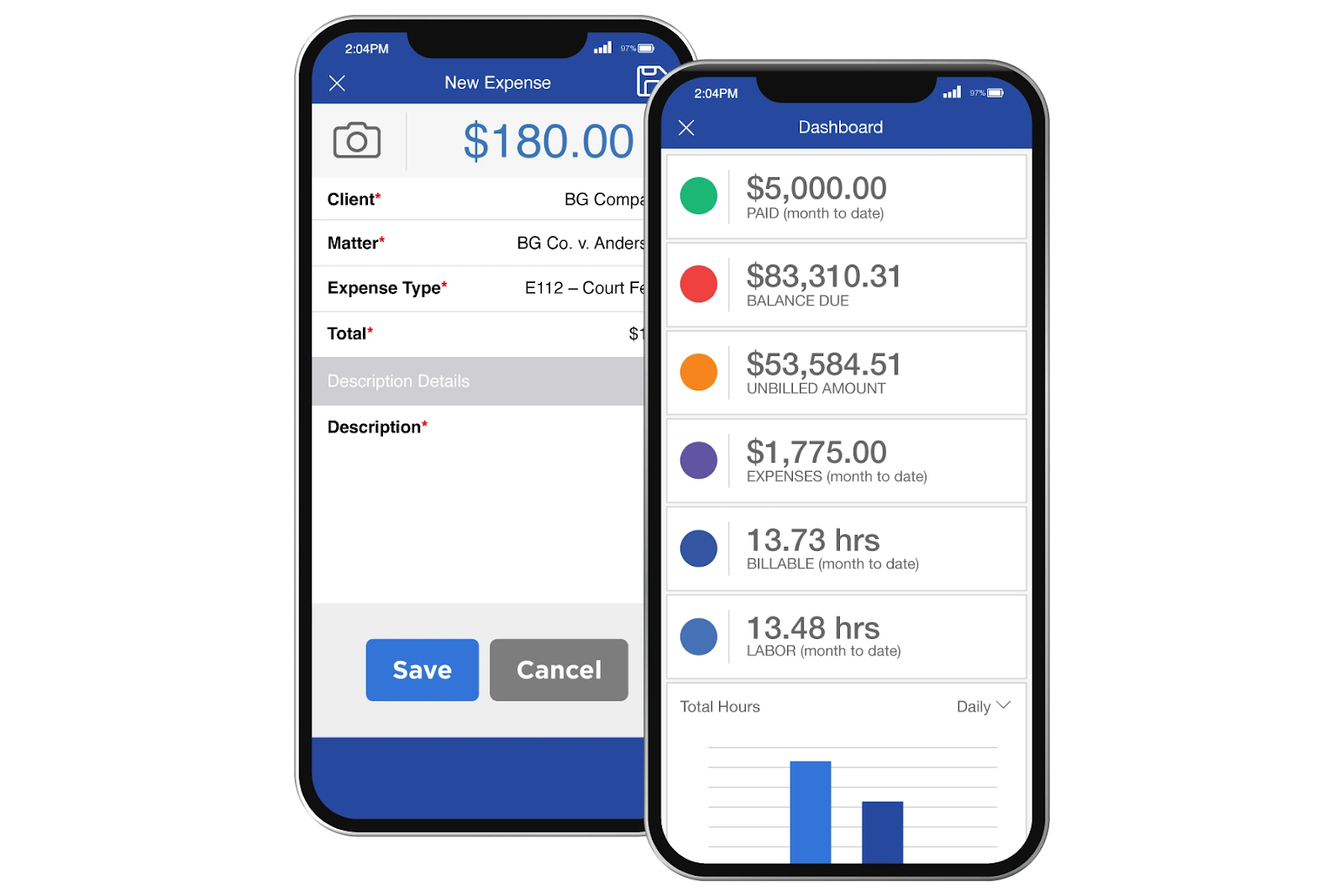
Bill4Time is another popular billing and time-tracking software for lawyers with scalable price tiers supporting solo practitioners to large firms. Features include advanced billing tools like contingency arrangements and customized invoices.
Features:
- Trust accounting
- Expense tracking and invoicing
- Basic CRM and case management tools
Pricing:
14-day free trial. Afterward (billed annually):
- Time & Billing: $27 per user per month.
- Time & Billing Enterprise: $67 per user per month.
- Legal Pro: $45 per user per month.
- Legal Enterprise: $80 per user per month.
Key differentiator: Task, client, and document management tools included in all subscription plans.
LeanLaw
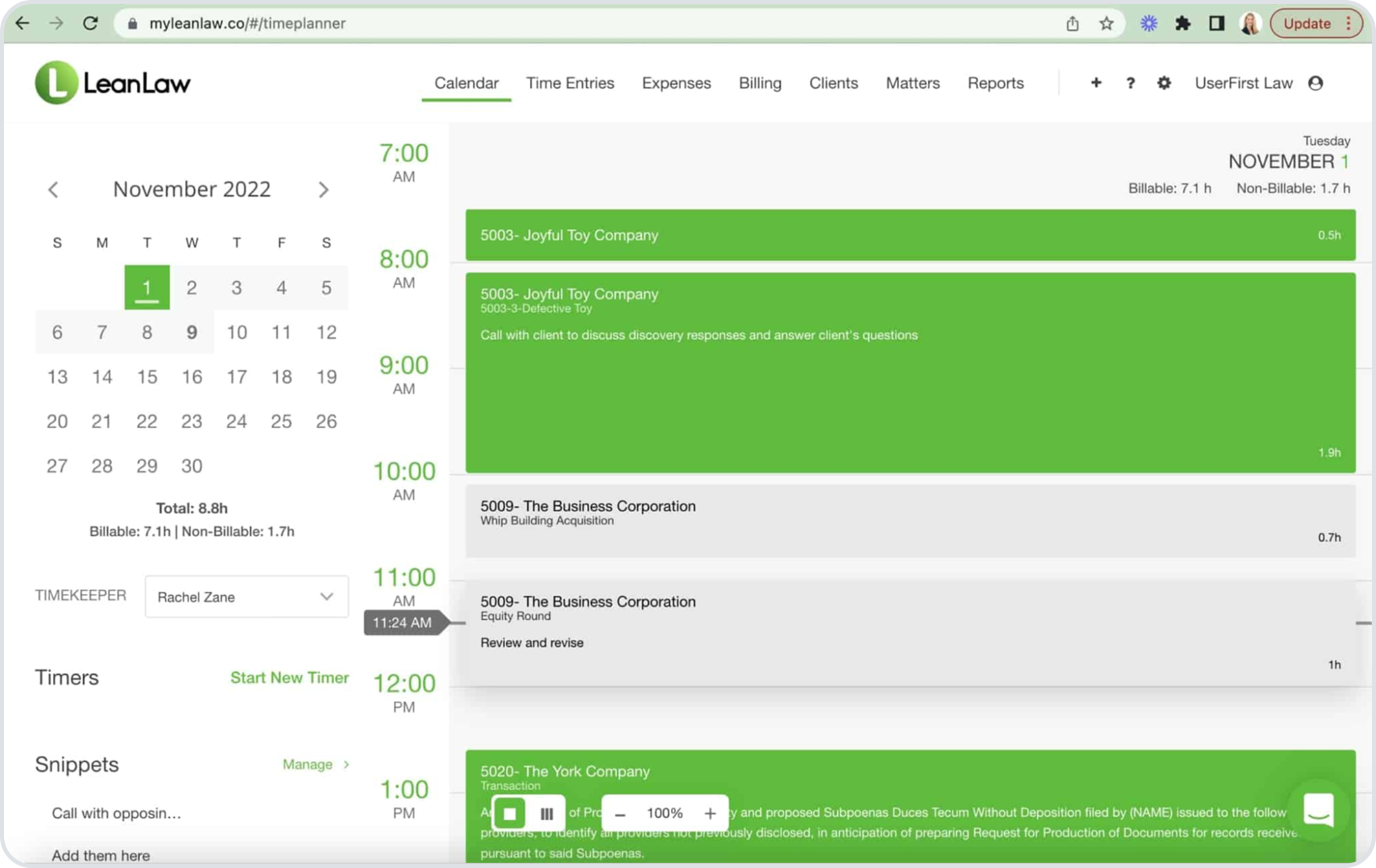
LeanLaw's intuitive interface makes it great for small and midsized firms seeking quick implementation.
While it has fewer native integrations than platforms like Lawmatics and TimeSolv, it compensates with user-friendly features like invoice templates and in-app timers for more accurate client invoicing.
Features:
- QuickBooks integration
- Invoicing and expense tracking
- Time tracking
Pricing:
7-day free trial. Afterward (billed annually):
- Core: $55 per user per month.
- Pro: $75 per user per month.
- Elite: Contact sales.
- Add-ons: Priority support, Custom reporting, Unlimited invoices, and Compensation tracking.
Key differentiator: Dynamic analytics dashboards providing real-time actionable insights into firm performance.
Choosing the Best Law Firm Software
When you’re ready for your next law firm technology, ask yourself:
- What kind of legal software does my firm need: CRM, practice management, document management, or time-tracking and billing?
- Does the platform create a great experience for my clients?
- How easy is the platform to use?
- Can it integrate with my current tech tools?
- What security protocols does it have?
- Will it adapt as my firm grows?
The best way to futureproof your firm? A CRM and intake platform that keeps prospects engaged with powerful marketing features and automated workflows that increase efficiency.
Don’t let leads slip through the cracks. Request a demo of Lawmatics, the leading legal CRM and client intake software. See how it integrates seamlessly with tools like Clio, 8am MyCase, and PracticePanther to power your firm’s growth.
Frequently Asked Questions About Legal Software
Is cloud-based legal software secure?
Yes, when providers implement proper security and data governance policies. Look for compliance with data privacy laws like the CCPA and the SHIELD Act, plus information security standards like SOC 2 Type 2 or ISO 27001.
Legal software should also comply with HIPAA and, for billing and payments, the Payment Card Industry Data Security Standard (PCI DSS).
When choosing a platform, research its security standards. Ask vendors about confidentiality features, especially during file transfers. Features like 256-bit encryption, multi-factor authentication, privacy settings, access controls, and independent security audits indicate they take your data protection seriously.
What is the difference between legal CRM and practice management software?
While there's some feature crossover, legal CRMs focus on sourcing, engaging, and nurturing relationships with future and past clients. Practice management platforms focus on handling cases with existing clients.
Think of it this way: CRMs are for external marketing and maintaining client relationships. Practice management tools are for controlling your internal operations.
How much does legal software cost?
Most cloud-based legal software uses subscription pricing. Overall costs typically depend on features and user count, usually ranging from $30 to more than $200 per user per month.
You’ll also want to be on the lookout for hidden fees, such as costs for implementation, data migration, priority support, or customized reports and workflows.
What legal software is best for small vs. large law firms?
Small firms typically prioritize case management features that support their existing client base. These features may include matter management, document management, billable work tracking, and accounting software integrations.
Large firms often seek more advanced software, particularly CRM platforms, to automate repetitive tasks, engage prospects, and develop their brand and reputation for continued growth.
What features should I look for in legal software?
The features to look for in legal software largely depend on what’s important to you, whether it’s CRM, case management, document management, or billing and time-tracking.
Generally, look for platforms with automated workflows that eliminate manual administrative processes. These can give you more time for your clients’ cases. Features like client portals and appointment self-scheduling also free up your time while improving client experience.
Running a law firm means managing a lot of moving parts — from new inquiries and consultations to signed agreements and onboarding, let alone billable work. The more your pipeline grows, the more important it becomes to have systems that keep everything moving smoothly and nothing falling through the cracks. That’s where automation steps in — not just to save time, but to help you build a more scalable, conversion-ready intake process.In this month’s Deep Dive, Lawmatics Product Manager Devon Roth is joined by Clare Struzzi, manager of the account management team, to walk through how to get even more out of your automations and pipeline setup, so your firm can continue to grow.
Time Stamps of Key Takeaways
4:50 — Build an intentional pipeline
The webinar kicks off with Devon and Clare outlining how to build a clean, intentional intake pipeline that works across all practice areas. Rather than juggling multiple pipelines, they recommend one universal structure with milestone-based stages. Clare also shares tips from onboarding calls about using filters and tags to keep it flexible without adding complexity.
9:22 — Automate key workflows
In this section, Devon demonstrates how automations can replace manual tasks — like sending emails, changing statuses, or converting leads — so your team can focus on high-touch client work. The takeaway: Automation isn’t just about speed — it’s about setting your firm up to scale responsibly.
27:00 — Using triggers and actions
This section covers the full automation lifecycle, from what sets a workflow in motion to what happens next. Devon breaks down key trigger types like form submissions, document completions, and field updates, then transitions into a demo of how to stack actions such as emails, tasks, delays, and conditionals. Clare adds strategic context around using advanced logic, testing automations with dummy matters, and avoiding common missteps.
43:59 — Exit conditions and next steps
In the final segment, Devon and Clare demonstrate how exit conditions ensure automations stop when a lead hires, is lost, or moves forward, preventing redundant follow-ups. A key example is the engagement agreement: Once it’s signed, Lawmatics can automatically convert the lead to a hired matter, trigger a welcome packet, and end any drip campaigns still running. Your hosts wrap by emphasizing the importance of sub-statuses for tracking lost leads and using conversion actions to maintain clean data and syncs across systems.
Webinar slide deck
When a client needs to send over a copy of their ID or an accident photo, they’re not looking for a complicated process. They don’t want to log into a portal, track down your email address, or dust off the household scanner. They want to do what they already do dozens of times a day: take a picture on their phone and hit “send.”Now, they can — directly to your firm’s text thread.We’re excited to introduce MMS messaging in Lawmatics, a new add-on feature that makes it easier than ever for clients to share what you need. With MMS enabled, your clients can send photos and other media files straight to your firm via text message, no extra steps required. It’s fast, convenient, and designed for the way people actually communicate today.And because it all flows into Lawmatics, your team gets complete visibility — without ever chasing an email or wondering where that document went.
Why law firms need MMS
Law firms have long used SMS in Lawmatics to confirm appointments, send reminders, and streamline the intake process. It’s a fast, reliable way to keep communication moving — especially during those early client interactions where speed and clarity matter most.Now, with the addition of MMS, there’s an even more convenient option when a client wants to share something visual. Whether it’s a photo of a document or an ID, clients can send it directly by replying to a text message — no need to switch to email or upload through another system.For clients who are on the go or not especially tech-savvy, it’s a natural extension of how they already use their phones. And for firms, it’s a simple way to keep all communication in one place. A quick handoff of information is especially useful in early-stage conversations, where momentum can mean the difference between a retained client and a lost opportunity. It also helps prevent small delays from snowballing; when an item isn’t in-hand, you can’t move forward.
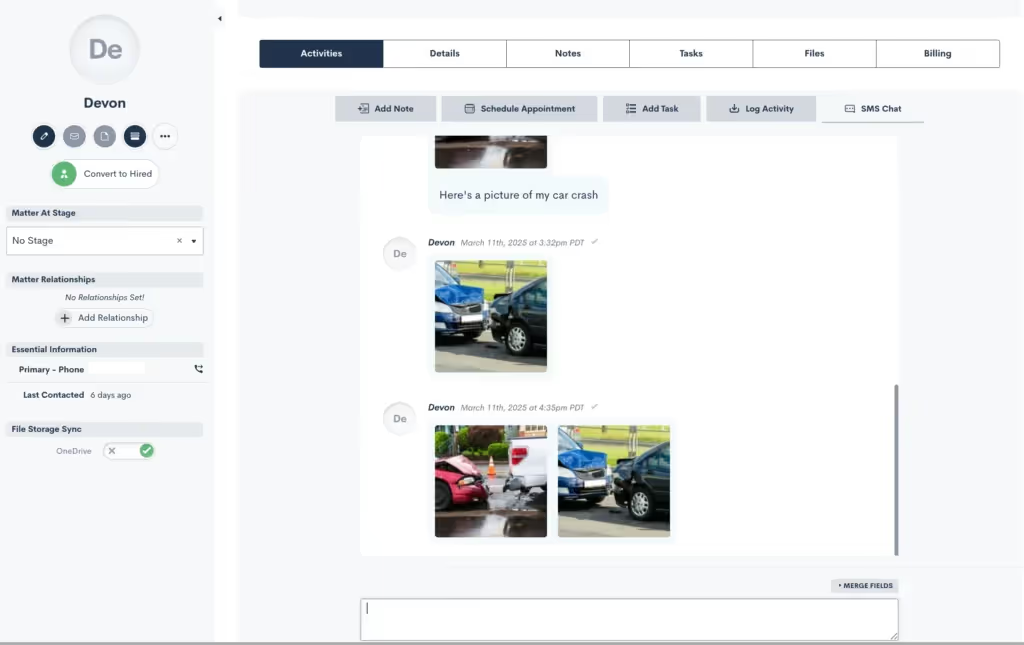
How MMS messaging works
MMS is an add-on feature that builds on your existing SMS capabilities in Lawmatics. Once enabled, clients can simply reply to your text with a file.Supported file types include standard formats like .jpeg and .png. You’ll see incoming media directly in the conversation thread within Lawmatics. From there, your team can take whatever next step is needed — whether that’s moving the intake forward, assessing the file in the client’s record, or triggering an automation based on the update.
Where MMS makes the biggest impact
While MMS is helpful across the board, in some practice types, the convenience can be a game-changer.Take personal injury, where documentation often includes real-time photos of injuries, accident scenes, or vehicle damage. Now, they can just text it, and you’ll receive it within seconds. And because Lawmatics is SOC 2 Type 2 and HIPAA compliant, your firm can safely receive even sensitive medical or personal records through MMS without worrying about where or how those files are stored.Alternatively, in immigration law, there’s often a long list of required documents: passports, visas, birth certificates, proof of residency, and more. Clients may not have ready access to email or may be coordinating with family members across borders. MMS lets them send what they have on hand right away, without needing a laptop or scanner.Even in estate planning, family law, or criminal defense, there are plenty of moments where a client needs to share a physical document, handwritten note, or piece of mail. With MMS, they can take a photo and send it through the text thread they’re already using to communicate with your firm. It’s easy, intuitive, and completely in line with how they already use their phones.
Built for a client-centered experience
For your firm, MMS means fewer delays, fewer follow-ups, and fewer dropped balls. For your clients, it means a legal process that feels more responsive and modern. Instead of “please send that via email when you get a chance,” they hear: “you can just text it.”And that shift matters. When clients feel like it’s easy to work with you, they’re more likely to follow through, stay engaged, and trust the process. And when your team has the files they need, exactly when they need them, they can serve clients more efficiently and effectively.
Getting started with MMS
At the end of the day, adding MMS support is about reducing friction in one of the most common parts of the legal journey: sharing photos and documents. Your clients expect to communicate with you as easily as they do with friends or family — and now, they can.If you're already using Lawmatics, enabling MMS is a simple upgrade. Once the feature is activated on your account, all incoming client messages will support media attachments, with no extra setup required on your end. To enable MMS for your firm, just reach out to your account manager or use this form to sign up.Not using Lawmatics yet? Get a demo to see how our platform helps law firms streamline communication, automate intake, and deliver a better client experience from day one.
We know running a law firm means juggling a ton of software. And while each tool is supposed to make things easier, sometimes it feels like they just add more to your plate with duplicate data entry, wasted time, and clients who feel neglected.That’s exactly why we’d like to spotlight our Lawmatics integration with MyCase, one of the leading case management platforms. With this powerful connection, you can manage the entire client lifecycle — from initial inquiry to case resolution and beyond — without the hassle of manual data transfers.
What this integration does for you
Your team shouldn’t have to spend time manually copying client details from one system to another. Technology should lighten the administrative load, not add to it. By linking Lawmatics with MyCase, you get a frictionless transition from client intake to case management, ensuring a more efficient workflow and a better experience for both clients and your team.
A smooth connection from Lawmatics to MyCase
Lawmatics users can automatically or manually sync matters over to MyCase. Any records that have been created in Lawmatics as matters will be pushed into MyCase along with corresponding details like notes and files.
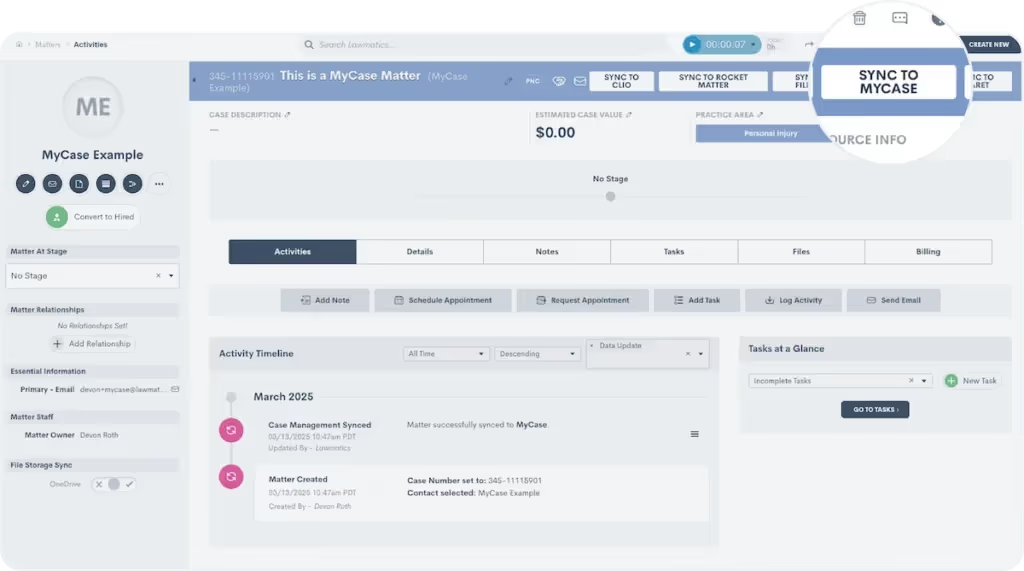
Activating the integration takes just moments. From there, you can define triggers that automatically transfer matter details to MyCase. For example, once a client signs an engagement agreement in Lawmatics, their case file can instantly sync to MyCase, keeping everything up to date without extra effort from your team.
Sync matter details and files automatically
When integrating MyCase with Lawmatics, you can map custom fields from Lawmatics to custom fields in MyCase. Plus, when a matter syncs or converts from Potential New Client to Hired, any files attached to the existing matter in Lawmatics will also move over to MyCase.
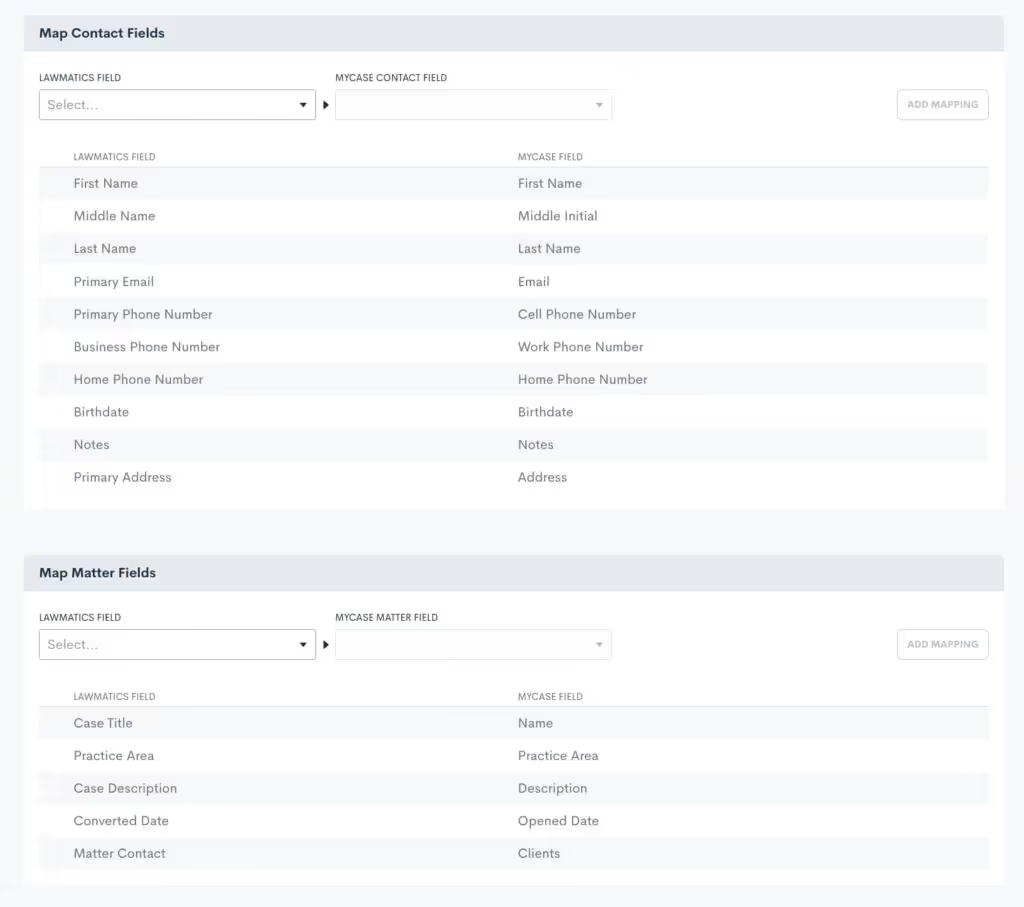
All of the manual work of making sure all details and relevant files get moved over to MyCase will be taken care of on the Lawmatics integration page.
How to integrate Lawmatics and MyCase
Already using both platforms? Setting up the integration is quick and easy. Just head to the integration settings page in Lawmatics, click the MyCase icon, and follow the simple connection steps. You’ll need your MyCase login credentials, so have those handy. For more information, please visit our Help Center.

Get started with Lawmatics + MyCase
If you’re a MyCase user looking for a better way to manage client intake, schedule a demo with Lawmatics today and see how our growth platform can take your firm to the next level.For more details on this and other Lawmatics integrations, check out our dedicated integrations page.
Big changes are here, and we couldn’t be more excited to share them with you! We decided there was no better way to start the year than by giving Lawmatics a refresh — one designed to make your experience smoother and more straightforward.This isn’t just a facelift; we made these updates based on extensive research into how our users access different features throughout their day. A new layout, smarter organization, and refined workflows mean you’ll spend less time clicking through menus and more time on revenue-generating tasks.
Welcome to the new navigation panel

The first thing you’ll notice is that the navigation bar has moved — from the top of the screen to a sleek sidebar on the left. Here’s what’s new:
- Simplified menu structure. We’ve grouped related tools and tabs to better reflect your workflow. Some of our previous groups were a bit broad, so we created labels that are more intuitive.
- Persistent access. Now, when you open a tab, it stays open, making it easier to navigate without losing your place. This update builds on the previous design by keeping key menus readily accessible as you work.
- Collapsible design. Prefer more screen space? Collapse the sidebar for a cleaner, distraction-free view — perfect for reviewing matters or data.
- One-click buttons. New navigation buttons now take you straight to frequently used pages in the app, like the Calendar and Dashboard, making it even easier to get where you need to go.
Automations and reminders
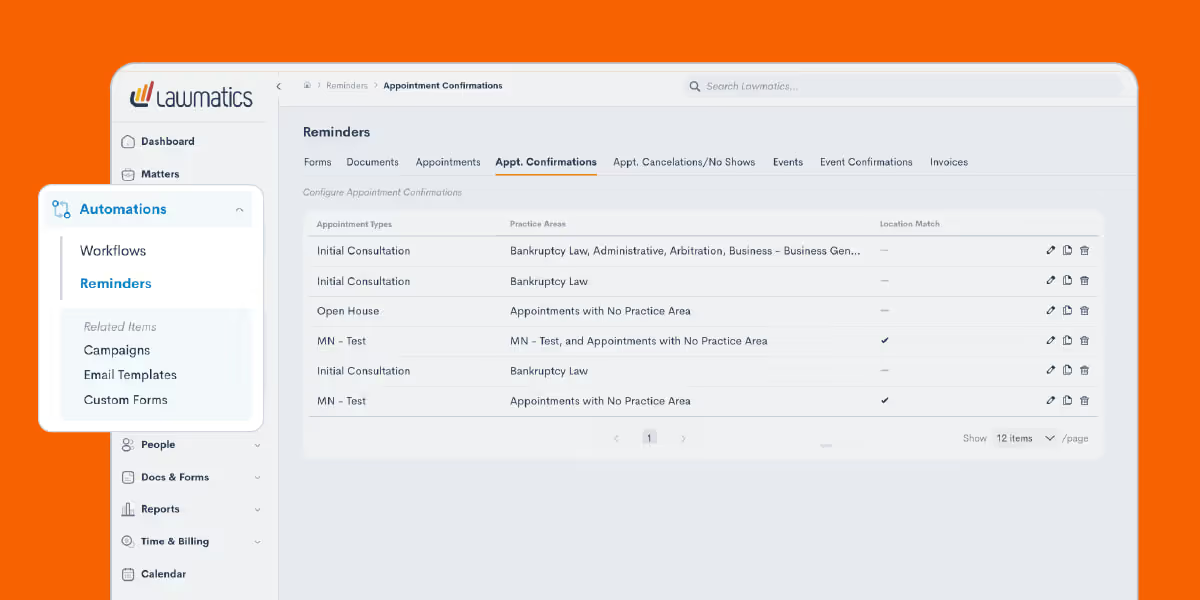
To make automation management and reminders more accessible, we’ve reorganized these tools into a centralized location. Your automation builds are now called Workflows, a name that better represents their function and simplifies navigation. This group now also consolidates all of your reminders, from forms to invoices, into one place. Now, instead of being spread across different features, reminders are all housed in a single hub, making them easier to track and manage than ever.
One marketing hub for client engagement
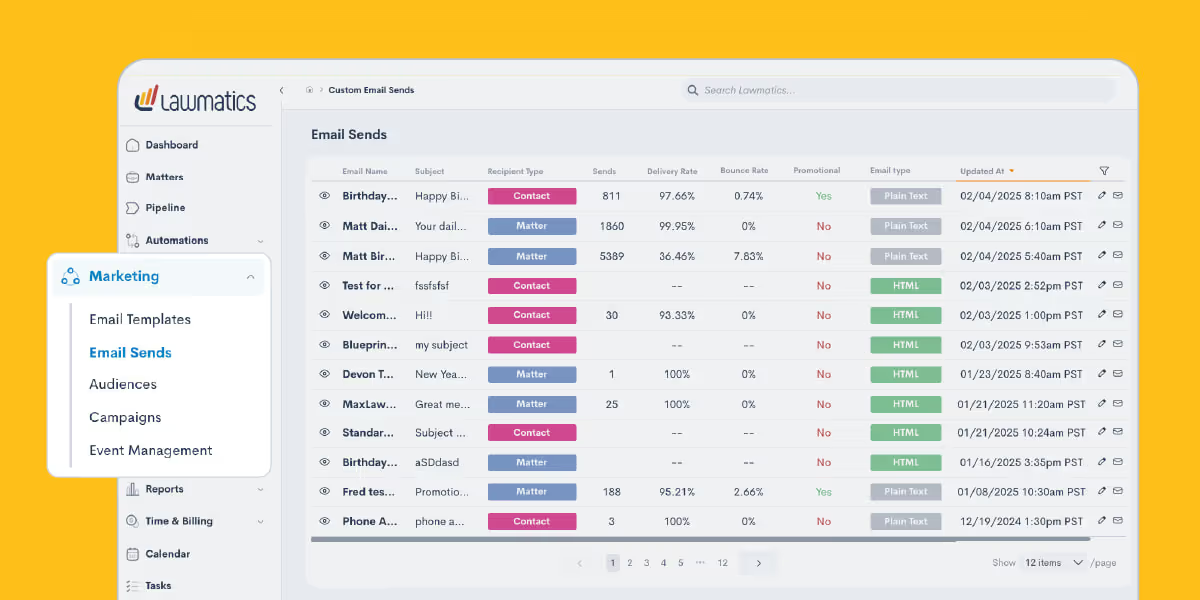
Your Marketing tab has been reimagined to create a seamless journey from initial contact to lasting engagement. Now, everything is structured to help you connect with potential clients, nurture relationships, and drive conversions in a way that feels natural and intuitive.
Emails
Start with Email Templates, where you can craft messages that resonate every time. Save your best-performing content and repurpose it effortlessly, ensuring consistency in your outreach. When it’s time to send, head to Email Sends, your go-to for delivering targeted messages to leads and existing clients with just a few clicks.
Audiences
To ensure your emails land with the right audience, the Audiences tab allows you to organize contacts into meaningful groups. A personal injury firm, for instance, might segment contacts by case type — auto accidents, slip-and-fall claims, or workplace injuries — so each message is hyper-relevant. This way, every email is not just sent but resonates with recipients, guiding them toward the next step in their legal journey.
Campaigns & event management
With your emails in motion, the Campaigns tab becomes your control center. Here, you can track performance, tweak messaging based on real-time insights, and optimize engagement. But what happens when an email sparks interest, and a lead wants to learn more? That’s where Event Management comes in. Whether it’s a live webinar, an educational lunch-and-learn, or an in-person networking event, you can manage registrations, track attendees, and follow up afterward. This keeps potential clients engaged and strengthens your connection with them before they even step into your office.By organizing the Marketing tab around the natural flow of client engagement, Lawmatics turns your outreach efforts into a well-oiled machine — attracting, nurturing, and converting leads with ease.
Contacts and matters
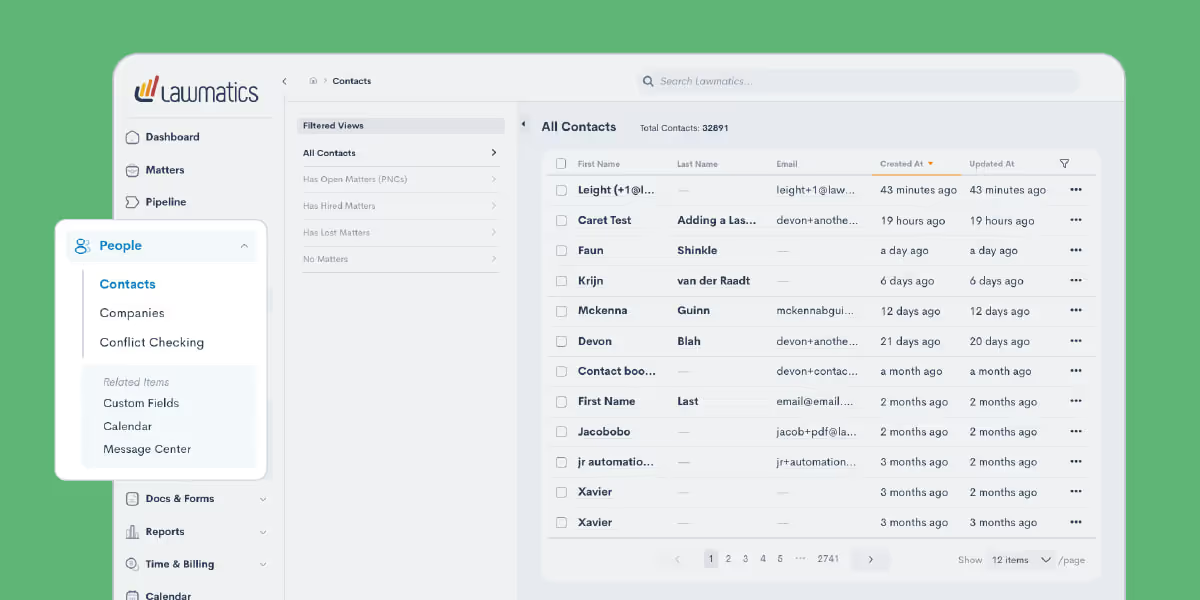
Most of the features previously found under the CRM group are now housed in the new People tab, the central hub for everything related to your clients. Here, you’ll find key details like contact information, company associations, and conflict checking.But managing client relationships isn’t just about storing information; it’s about meaningful engagement. That’s why we’ve also included tools that help you take action. For instance, after reviewing a client’s personal details, you may want to follow up with them directly. To make that next step as simple as possible, we’ve added a direct link to the Message Center under the People tab, allowing you to send an email without disrupting your workflow.
Documents and forms

The first change here is that we relabeled this group from Assets to Docs & Forms, your one-stop shop for information sharing. Emails have moved to the Marketing tab, while most other features remain in this section for easy access.To streamline navigation, we’ve separated some existing functions. Document Templates, for example, have their own page, and we’ve added a new E-Signatures section for you to monitor your document signing requests. While new e-signature documents can’t be created from this page, you can monitor when requests were sent and whether they’ve been completed.We applied this same approach further down in this section — File Request Templates and File Requests are now distinct, making it easier to manage each separately. You’ll also find Firm Files here, a central space for storing welcome packets, images, and other attachments you regularly use with clients.
Recap
The brand-new Lawmatics interface is about giving you a platform that works the way you do. Every one of these changes is based on user feedback and real-world usage patterns. We are pumped for how these upgrades will make your daily workflow even smoother and more efficient. And we’ve got even more updates planned — so stay tuned throughout the year!If you haven’t used Lawmatics yet and want a firsthand look at the platform, now is the perfect time to check it out. Get a fully personalized demo and see for yourself how we’ve built our platform with legal professionals like you in mind.
For law firms, managing client data across multiple platforms has always been a headache. Entering details into multiple systems, making new typos at every turn, wasting precious time that could be better spent helping clients — juggling data like this is frustrating, inefficient, and frankly, risky.The good news? We’re continuing to build solutions to meet legal professionals where they are.Our recently announced integration with CARET Legal is designed to eliminate hassle, minimize risk, and save administrative hours that tend to add up.Watch the webinar below to see the integration in action, or keep reading for a full breakdown of how it works and what it means for your firm.
Why integrate with CARET Legal?
Transferring data from intake to case management systems is a time-sucking ordeal for most firms. This process pulls focus away from serving clients and generating revenue. In many law firms, this kind of data work is how nearly half of a lawyer’s non-billable time gets spent on administrative tasks.Every manual keystroke introduces a new chance for entry errors, omissions, and other costly mistakes. Data mishaps can have serious repercussions like miscommunication, erroneous invoices, and shaken client trust.By connecting our CRM to CARET Legal, we’re lifting this burden off law firms, while providing complete control over data management. With this integration, you’re not just streamlining your processes — you’re gaining peace of mind.
Seamless data transfer between systems
Forget fumbling between platforms and re-entering the same matter details over and over again. Our integration takes care of that for you. With just a few clicks — or a pre-set automation — your client data hops seamlessly from Lawmatics to CARET Legal. This instant sync keeps your information flowing from intake to case management, making those cumbersome transfer processes a relic of the past.
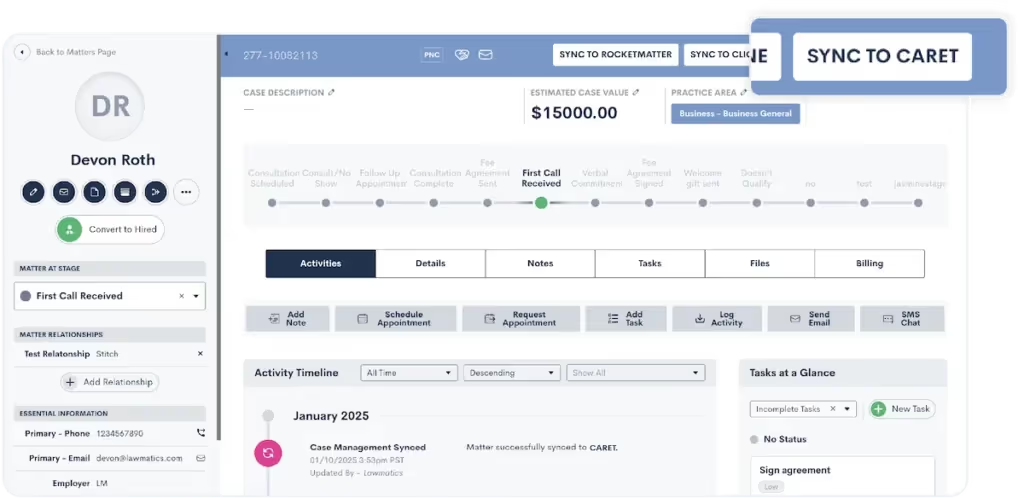
Here are your options for how to sync matters:
- Sync manually: When a matter is ready to sync to CARET Legal, just click on the “Sync to CARET” button on the top right of your screen and confirm your choice.
- Sync automatically: Set up an automation that triggers the matter to sync to CARET Legal upon the matter converting to a Hired status.
Maintain data integrity with confidence
The phrase “garbage in, garbage out” haunts every intake manager. And inconsistent data can spell trouble faster than you can remember how to spell “certiorari.” In fact, an ABA study found that administrative errors, like clerical errors and lost files, accounted for 23% of all malpractice claims a few years ago.But now, with this integration, you can rest easy knowing that data integrity is maintained at every step. With a simple transition from one stage to the next, you can be confident that your data is always clean, consistent, and accurate. Say goodbye to typos and discrepancies.
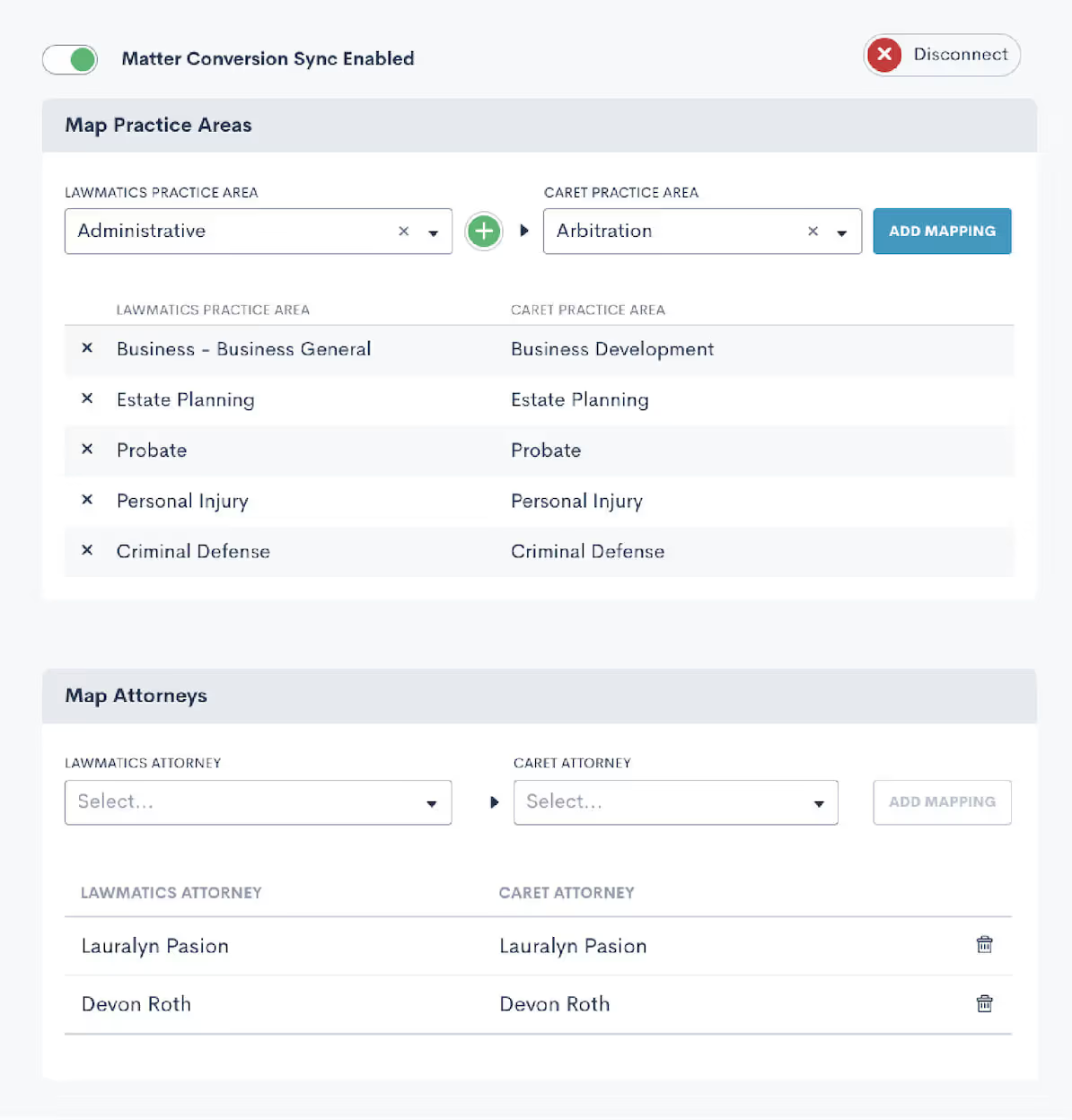
Save time on administrative hassle
Time is your most valuable resource, and every minute wasted on repetitive tasks is a minute you can’t dedicate to clients. The Lawmatics + CARET Legal integration takes tedious tasks off your plate, creating more time for clients and building your business. In a nutshell: more productivity, less busywork. Refocus those energies into client service or tasks that actually generate revenue.

Get started with Lawmatics + CARET Legal
It’s time to reclaim your day from the clutches of inefficient processes and redundant data entry. The Lawmatics + CARET Legal integration is here to make your workflows smoother, your data more reliable, and your practice more efficient. Current Lawmatics users can log in to set up your integration today.If you’re a CARET Legal user looking to revolutionize intake for your firm, book a Lawmatics demo to check out our CRM for yourself.If you’re interested in learning more about CARET Legal, visit our dedicated integration page.
Why SEO matters: The mindset of today’s legal consumer
Imagine you’re a potential client searching for a lawyer. You’ve just been in a car accident, and your insurance company is dragging its feet. What’s the first thing you do? You pull out your phone and type something like, “best personal injury lawyer near me.”This moment — when someone searches for a solution to their legal problem — is what SEO is all about. It positions your firm at the exact point where intent meets action — one of the tenets of digital marketing for law firms.Here’s why it pays to pay to have the best SEO for law firms:
- Legal consumers are searching, and fast: Research shows that 68% of all online experiences start with a search engine. Legal consumers don’t casually browse—they look for attorneys when they need help now. If your firm isn’t optimized to show up, another firm will be.
- They trust Google’s results: About 75% of users never scroll past the first page of search results. Think about it: When was the last time you clicked to page two? Being at the top of the results isn’t just a nice-to-have—it’s critical.
- They want answers instantly: SEO ensures your firm appears in local search results like Google’s Local Pack, where potential clients can immediately see your contact information, reviews, and location.
SEO as a Digital First Impression
If your website isn’t optimized for search, it’s like having an office with no signage or an empty lobby. SEO ensures you’re not only visible but credible. When potential clients see you ranking high in search results, they assume your firm is established, reputable, and capable.
Why do law firms need marketing, generally speaking?
Now that we’ve established the importance of SEO, let’s broaden the scope. Digital marketing isn’t just about ranking higher in search results; it’s about creating a comprehensive strategy that consistently brings in leads. While referrals still matter big time in legal, the average consumer expects to find you online, trust your reputation (think reviews and rankings), and quickly access the answers they need.Today’s law firm marketing revolves around:
- SEO (Search Engine Optimization): Getting your firm to rank for high-intent searches like “construction lawyer near me.”
- Google Ads (PPC): Claiming premium placement at the top of search results, ensuring visibility when potential clients need you most.
- Content Marketing: Publishing resources like blog posts or guides that build trust and reinforce your expertise.
If you’re not visible online, you’re invisible to prospective clients. The right digital strategy creates a predictable system for generating legal leads and converting them into loyal clients.
How much do law firms spend on marketing?
Once you understand the why, it’s time to explore how much. Let’s break it down.
How much do law firms spend on SEO?
SEO is the long game — and for good reason. On average, law firms spend $3,000 to $10,000 per month on SEO services, depending on factors like competition, practice area, and market size (source).Why the investment?
- Content-Driven Traffic: Optimized blogs, service pages, and FAQs tailored to your practice area drive qualified traffic.
- Technical Optimization: Fast, mobile-friendly sites are essential to rank well and keep users engaged.
- Local Dominance: A family law firm in Dallas can attract more cases by appearing in “local pack” results for queries like “child custody lawyer near me.”
SEO pays dividends in the form of steady, organic traffic — but it requires consistent attention and expertise.
How much do law firms spend on Google Ads?
Google Ads is where speed meets precision. The average Google Ads budget for law firms ranges from $5,000 to $15,000 per month, with some firms spending far more in high-stakes niches like personal injury.What drives costs?
- Sky-high CPCs: Legal keywords are some of the most expensive, with costs per click often exceeding $100.
- Intense competition: A DUI lawyer in a major city like Chicago or Miami may face aggressive bidding wars for keywords like “criminal defense attorney.”
- Results you can track: Unlike SEO, Google Ads delivers quick wins but requires ongoing optimization to ensure ROI.
Google Ads is ideal for firms looking to attract high-intent clients quickly, but costs can skyrocket without proper management.
How much should a law firm spend on marketing?
Here’s the golden rule: successful law firms allocate 2–10% of gross revenue to marketing. Newer or smaller firms may need to spend more to establish their presence, while established firms with a loyal client base might spend less proportionally but more in absolute terms.A smart allocation for digital marketing might look like this:
- 30% to SEO: Build a foundation for long-term growth.
- 40% to Google Ads: Drive immediate traffic and leads.
- 20% to Content Marketing: Showcase expertise and engage potential clients.
- 10% to Social Media: Strengthen your brand and stay connected with your audience.
For example, a personal injury firm generating $2M annually might allocate $150K to marketing, investing $45K in SEO and $60K in PPC to dominate local searches while producing educational content on common accident claims.
The key to getting ahead: Lawmatics
Visibility isn’t optional — it’s the deciding factor in whether a client calls your firm or moves on to the next result. If your marketing feels piecemeal or outdated, it’s time to take a smarter approach.That’s where Lawmatics comes in. Our platform integrates lead generation, client relationship management, and marketing automation to help your firm attract, engage, and convert more clients. From SEO strategies to automated follow-ups, we give you the tools to dominate your market.Request a demo today and see how Lawmatics can transform your firm’s marketing strategy for 2025.
Picture this: It’s late at night, and a potential client is frantically Googling “best criminal defense attorney near me” after an unexpected run-in with the law. Now imagine your firm isn’t even on the first page of results. That’s not just a missed opportunity — it’s a client for your competitor.The reality is that 46% of all Google searches have local intent (Saga Pixel). That means almost half of the online world is actively looking for local services like yours. If your law firm isn’t investing in digital marketing for law firms, particularly local SEO, you’re invisible. Let’s break down why local SEO is your secret weapon for getting found and growing your practice.
Do Law Firms Need SEO?
Absolutely, and here’s why.SEO (Search Engine Optimization) is the strategy that makes your law firm discoverable online. Without it, your website becomes an expensive business card gathering dust in a corner of the internet.For example, if you’re a personal injury lawyer in Atlanta and someone searches for “car accident attorney near me,” SEO ensures your firm has a fighting chance to appear. But it’s not just about showing up — it’s about showing up in the right places, at the right time.SEO builds trust and authority by aligning your website with search engine expectations. This includes having fast-loading pages, mobile-friendly design, and relevant, keyword-rich content. For law firms, it’s the difference between being someone’s first choice and being invisible.
What is Local SEO in Digital Marketing?
Local SEO is how your law firm becomes a household name in your area. Unlike traditional SEO, which casts a wide net, local SEO zeroes in on your specific geographic location, ensuring you’re found by people searching nearby.
Local SEO for Lawyers: A Strategic Advantage
Law is inherently local. Clients look for attorneys who understand the laws and nuances of their area. Local SEO bridges the gap by focusing your digital marketing efforts on attracting nearby clients. Here’s how:
- Optimized Google Business Profile (GBP): Ensure your listing includes accurate business hours, contact info, and client reviews to dominate the Local Pack.
- Localized Content: Blog posts addressing region-specific legal topics can establish authority.
- Location-Specific Keywords: Phrases like “real estate attorney Los Angeles” or “divorce lawyer Tampa” help you rank for searches in your area.
Local SEO Examples That Work
- A DUI attorney in Houston creating blog posts about Texas DWI laws.
- A workers’ compensation lawyer in Chicago ensuring their GBP includes reviews mentioning quick settlements.
- A probate law firm in San Diego embedding “San Diego probate lawyer” across service pages and meta descriptions.
Is Doing Local SEO Worth It?
If your goal is to grow your client base, local SEO is non-negotiable. But don’t just take my word for it—here’s why local SEO for lawyers is a game-changer.
Why Local SEO is Important for Law Firms
Google’s algorithm favors proximity. In fact, almost half of all Google searches have local intent. If you’re not showing up in searches like “criminal defense lawyer near me,” you’re leaving money—and clients—on the table.
Benefits of Local SEO
- Higher Visibility: Appear in local searches where potential clients are actively looking.
- Enhanced Credibility: Reviews and star ratings position you as a trusted choice.
- Cost-Effective Marketing: Focus your budget on clients most likely to hire you.
- Stronger Community Presence: Local SEO reinforces your reputation as an integral part of your community.
When executed correctly, local SEO positions your law firm as the first and most trusted name people see when searching for legal help.
How Much Do Law Firms Spend on SEO?
SEO is an investment, but it’s one that can pay off exponentially. On average, law firms allocate $2,500–$10,000 per month for SEO services, depending on their location, competition, and the scope of their campaign.Here’s a breakdown of what factors into those costs:
- Keyword Research: Understanding what clients are searching for.
- Content Creation: Regularly publishing high-quality, relevant blog posts and pages.
- Technical SEO: Ensuring your website is fast, mobile-friendly, and optimized for search engines.
- Link Building: Establishing your site as an authority through backlinks from trusted sources.
For local SEO, the costs can be even more focused. Instead of competing on a national level, you’re targeting a smaller, more specific audience, often making campaigns more affordable while delivering higher returns.
Turn Google searches into clients
Your law firm’s visibility can be the deciding factor in whether potential clients choose you—or the firm down the street. Local SEO ensures that you’re not only visible but also the first choice when it counts.If your current digital marketing strategy feels outdated or scattered, let us help. Our software is designed to give your firm the edge it needs in today’s competitive market. Request a demo today, and take the first step toward owning your local market.
Picture this: a potential client needs legal help. They grab their phone, type "divorce lawyer near me," and within seconds, they’re scrolling through the top results on Google. Considering that 38% of clients initiate their search for legal assistance online (Finances Online), if your law firm isn’t on that first page, you’re practically invisible. That’s the power of digital marketing for law firms, and at the heart of it lies SEO (Search Engine Optimization).SEO isn’t just a trendy buzzword — it’s the backbone of how law firms attract, engage, and retain clients in a digital-first world. And if you're not investing in it, you’re leaving opportunities (and revenue) on the table.
What Is SEO for Law Firms?
There’s more to SEO for lawyers than merely sprinkling keywords on your website. It’s a multi-faceted strategy to ensure your firm shows up when someone searches for legal services you offer. Think of it as your online reputation manager and lead generator rolled into one.Here’s what it includes:
- Keyword research and optimization: Identifying phrases like “divorce attorney in [city]” or “real estate lawyer near me” that potential clients are searching for.
- Technical SEO: Ensuring your website is fast, secure, and mobile-friendly—because no one has patience for a slow site.
- Content marketing: Producing valuable resources like blog posts, FAQs, and eBooks that answer client questions.
- Local SEO: Optimizing for location-specific searches to dominate your area’s results.
- Backlink building: Earning links from reputable websites that signal your authority to search engines.
SEO for law firms is essentially your online handshake with potential clients. When done right, it positions your firm as the go-to expert before they’ve even spoken to you.
Do Law Firms Need SEO?
Short answer? Absolutely.The days of relying solely on word-of-mouth referrals or billboard ads are long gone. Most clients start their search for legal help online, and if your firm isn’t showing up in those searches, your competitors are.
What Is Law Firm SEO Content?
Law firm SEO content is what gets potential clients to stop scrolling and start engaging. This isn’t about stuffing pages with generic legal jargon; it’s about creating meaningful, search-friendly content that speaks directly to your audience. Examples include:
- Practice area pages: Highlight your services in detail, from family law to corporate litigation.
- Case studies: Share real-world examples of how you’ve helped clients achieve favorable outcomes.
- Educational blog posts: Break down legal jargon into plain English, answering questions like “What happens during a bankruptcy filing?”
Good SEO content answers questions before they’re asked, building trust and credibility while driving traffic to your site. Remember, you’re building relationships with potential clients, and often it starts here.
Why Are Local SEO Services Important?
Location is everything. For most legal clients, proximity is a top factor in choosing an attorney. That’s where Local SEO for lawyers comes in.Local SEO ensures your firm appears in geographically relevant searches, particularly in Google’s coveted local map pack. Here’s what that means for your firm:
- Dominate local searches: Optimize for terms like “immigration lawyer in [city]” to capture nearby clients.
- Strengthen your Google My Business profile: Keep it up-to-date with accurate contact details, hours, and client reviews.
- Encourage reviews: Positive reviews don’t just build trust — they help your rankings.
The best SEO for law firms doesn’t just attract visitors; it ensures the right people—local clients—find you at the exact moment they need help.
How Much Do Law Firms Spend on SEO?
Investing in SEO isn't just about visibility; it's about return on investment. On average, law firms allocate around $150,000 annually to SEO efforts, yielding a remarkable 526% ROI over three years (Rank Tracker). SEO costs can vary widely depending on your firm’s size, goals, and competition. Here’s a breakdown:
- Smaller firms: May spend $1,500–$3,000 monthly for a modest foundational strategy.
- Mid-sized firms: Typically invest $3,000–$8,000 monthly for a robust approach, including local and technical SEO.
- Larger firms: Often spend $10,000+ monthly for aggressive campaigns targeting highly competitive markets.
Is it worth it? Absolutely. With high-value cases often exceeding five or six figures, a single client secured through SEO can cover months — if not years — of investment.
Turn searchers into clients with Lawmatics
Ignoring SEO is like letting a golden opportunity slip through your fingers. It’s the difference between being a local leader or an afterthought in search results. By leveraging SEO, your firm can capture the attention of high-value clients exactly when they’re searching for your services.Want to rise above the competition? Lawmatics offers the tools and expertise to supercharge your digital strategy. Request a demo today and see how we can help your firm dominate the search results and grow your client base.
Legal marketing isn’t about waiting for referrals anymore. Today’s clients start their search for legal services on Google, comparing firms based on what they see across websites, reviews, and social media. If you’re a lawyer, being “visible” means more than just having a website—it’s about engaging clients where they’re already looking and delivering something memorable. Digital marketing for law firms is now a matter of survival. Without a clear strategy, you risk getting lost in the endless scroll. Below, we’ll dive into practical law firm marketing ideas to make sure you’re front and center when it matters most.
How do you advertise yourself as a lawyer?
A solid marketing plan is essential for capturing attention and building trust in an increasingly digital world. Think of it as your blueprint for reaching and engaging the right clients.
What are the 7 steps of a marketing plan?
Successful legal marketing hinges on structure and strategy. Here’s a seven-step plan to guide you through it:
- Define Your Target Audience. Zeroing in on your audience is non-negotiable. Maybe you focus on businesses needing intellectual property help or clients with family law needs. Craft your messaging to resonate with this target demographic and choose channels that align with their preferences.
- Set Clear Goals. Identify what you want to achieve and make it measurable. Are you aiming for a 30% increase in consultations or doubling your social media following? Specific goals help you measure what’s working.
- Analyze the Competition. Competitor analysis isn’t just about seeing who they are—it’s about understanding what they’re doing well and where you can do better. This insight can inform everything from your messaging to your ad placement.
- Create a Unique Value Proposition (UVP). Your UVP is what sets you apart. Maybe it’s your specialized knowledge, your approachability, or your track record. Make sure this value is front and center in your materials.
- Develop Key Marketing Strategies. Consider SEO, content marketing, social media, and PPC advertising. For instance, a well-optimized blog can answer client questions before they even ask, helping you become a go-to resource.
- Execute Your Strategy. Now, it’s time to roll out your tactics—launch campaigns, track web traffic, engage on social media, and nurture those leads.
- Measure & Adjust. Analyze results and pivot based on what you learn. Marketing is a dynamic process, so remain agile and ready to adapt to trends and client needs.
Can lawyers advertise on social media?
Absolutely, and it’s a must for staying relevant. Social media allows lawyers to showcase their expertise, interact with clients, and establish a personal brand. According to the American Bar Association, 35% of lawyers have gained clients through their social networking activities, proving that these platforms are more than just social—they’re crucial client-building tools. And while ethical guidelines apply on platforms like LinkedIn, Facebook, and Instagram, social media can add a much-needed human element to a lawyer’s brand.
What social media do lawyers use most?
While LinkedIn and Facebook have been reliable for years, lawyers today are branching out to other platforms like Instagram and TikTok, where they can reach younger clients or showcase firm culture.
- LinkedIn – LinkedIn remains a cornerstone for professional networking. It’s ideal for sharing thought leadership content, engaging with other professionals, and reaching corporate clients.
- Facebook – With its broad reach, Facebook works well for general updates, sharing testimonials, and posting blog links to drive traffic to your website.
- Twitter – Twitter is great for quick, insightful posts, sharing legal news, and staying visible in current conversations. Lawyers who want to weigh in on trending topics will find a home here.
- Instagram – Think of Instagram as a way to humanize your firm. It’s perfect for sharing behind-the-scenes looks, team events, or community involvement, giving a more personable touch.
- TikTok – Yes, even TikTok. Lawyers are increasingly using TikTok to create short, engaging videos that break down legal concepts, demystify jargon, and educate viewers in bite-sized segments.
Did you know?TikTok's monthly active users hit 1 billion in 2021, and it continues to grow as a powerful platform for business outreach
Social media for lawyers can be powerful when it’s done right, staying compliant with ethical standards while building a genuine online presence.
What Is the best form of advertising for a lawyer?
A mix of digital advertising tactics tends to work best, especially when customized to your unique strengths and client base. Here are some of the most effective forms of lawyer advertising:
- Search Engine Optimization (SEO) – Organic search traffic is pure gold for law firms. Clients actively searching for terms like “immigration lawyer near me” or “DUI attorney” are primed for conversion. Studies show that 96% of those seeking legal representation begin their search online, underscoring the importance of strong SEO for visibility.
- Pay-Per-Click Advertising (PPC) – With Google Ads, you can secure premium placement in search results, appearing right when potential clients are searching for your expertise. It’s a direct, effective way to generate leads from those actively seeking services.
- Content Marketing – Regularly posting insightful blogs, articles, or case studies positions you as a thought leader. By answering potential clients’ questions in advance, you’re building trust and proving your value before they even call you.
- Email Marketing – Email marketing is cost-effective and keeps your firm top-of-mind. Whether it’s monthly newsletters, legal updates, or tips, email lets you stay connected with both potential and existing clients.
A balanced law firm digital marketing strategy combines these elements to ensure that you’re visible, reachable, and engaging across multiple channels.
Take control of your firm’s growth with Lawmatics
A well-executed digital strategy can make all the difference in connecting with the clients you want. Our software is designed to support legal professionals like you in maximizing reach, engagement, and conversions, so you can spend less time on marketing and more on what you do best. Request a demo today to see how we can help your firm make a lasting impact.
Imagine you're scrolling through social media, and an ad for a law firm grabs your attention. But instead of the usual jargon, it feels like it speaks directly to you. That’s the power of smart advertising, and it’s what every law firm needs to compete in a fast-paced market. The legal industry is experiencing a shift—lawyers must now think like marketers to stand out. But with so many options out there, from digital campaigns to traditional billboards, what really works?It’s a question that more law firms are asking, especially as clients’ expectations for accessibility and service continue to rise. In fact, studies show that 96% of people seeking legal advice use a search engine (FindLaw) and 74% of law firms say they intend to invest more in digital marketing strategies over the next year (ABA). The data doesn’t lie—getting your firm noticed online is no longer optional, it’s a must. But let’s break down the forms of advertising that really make a difference for lawyers.
What is legal advertisement?
Legal advertisement refers to any form of promotion where lawyers market their services to potential clients. This includes everything from traditional TV ads and billboards to modern digital ads on social media. The ABA advertising rules are designed to ensure that law firm marketing remains professional and ethical, prohibiting false or misleading claims. A crucial part of navigating legal advertisements is staying up to date with the rules governing it, which can vary by state. While these rules might seem restrictive, they actually serve to build trust and maintain the integrity of the legal profession.
What kinds of advertising do lawyers most commonly use?
Law firms typically leverage a mix of traditional and digital advertising methods, depending on their target audience and goals. Here’s a breakdown of the most common forms of law firm advertising:
- Billboards. Yes, those huge signs lining the highways are still in use, especially by personal injury and criminal defense attorneys. These ads aim to capture the attention of drivers and pedestrians alike.
- TV and Radio Ads. Local commercials remain popular for attorneys seeking to connect with a broader, often older, audience.
- Pay-Per-Click (PPC) Ads. Lawyers increasingly use PPC ads on Google and Bing to target clients searching for legal help online.
- Social Media Ads. Platforms like Facebook, Instagram, and LinkedIn provide targeting tools to reach specific demographics, making it easier for lawyers to advertise their services to people who need them most.
Are billboards effective for lawyers?
Yes and no. Billboards can be effective in certain contexts, like personal injury or criminal law, where potential clients may make decisions quickly. However, billboards don’t always provide enough depth to fully explain a law firm's services, and the return on investment is often hard to track. So while they may work for visibility, they often don’t convert as well as digital marketing efforts, which allow you to directly target specific audiences.For example, billboard campaigns could make sense in high-traffic areas with repeated exposure to consumers, but they’re most effective when used alongside other strategies. In contrast, digital methods allow for more precise targeting and measurable results, which brings us to a more modern alternative: social media.
Can lawyers advertise on social media?
Absolutely. Lawyer advertisements on social media have skyrocketed in recent years as firms recognize the potential to reach new clients where they spend much of their time—online. Platforms like Facebook, Instagram, and LinkedIn are not only affordable but also offer advanced targeting capabilities, allowing law firms to reach specific audiences based on demographics, location, and even behavior.For example, a family law attorney could target ads toward individuals who have recently updated their relationship status. Similarly, a business law firm could run ads aimed at startups and small business owners. Social media advertising is cost-effective, trackable, and allows for creative ways to engage with potential clients through videos, testimonials, and case studies.
What is the best form of advertising for a lawyer?
Ultimately, the best form of advertising for a lawyer depends on the specific goals of the firm. While there is no one-size-fits-all solution, there are a few universal rules to keep in mind:
- For brand awareness. Traditional methods like billboards or TV ads can create broad awareness, especially if your practice serves a wide geographic area.
- For targeted outreach. Digital marketing, especially PPC ads and social media campaigns, allow for more precise targeting of potential clients. For instance, using law firm advertising examples as a guide, you could tailor ads for people searching for specific services like estate planning or DUI defense.
- For building trust. Client testimonials, reviews, and informative content on your website can act as powerful advertising tools. Content marketing, which includes writing helpful articles and guides on legal topics, positions your firm as a trusted authority.
As technology continues to evolve, so too do the advertising options available to lawyers. Regardless of which platform you choose, staying compliant with lawyer advertising rules is essential to protect your firm’s reputation and avoid any ethical violations.
Maximize your marketing efforts through automation and insights
The world of legal advertising is evolving, and your law firm needs to evolve with it. Traditional methods like billboards may still play a role, but the future lies in digital. By investing in smart, targeted online ads, your law firm can reach the right audience and stand out in a crowded market.Looking for a comprehensive way to elevate your law firm's marketing? Our software is purpose-built to help lawyers optimize digital campaigns, track leads, and grow their practices. Request a demo today and see how we can help your firm thrive.
Let’s cut to the chase: If your law firm isn’t mastering digital marketing, you're already behind. With more than 70% of legal consumers using online resources to find answers to a legal question, you need to be where they are. But we're not just talking about throwing up a website and calling it a day. The digital landscape is more competitive than ever, and to get ahead, law firms must adopt a strategic and comprehensive approach to online marketing. This means going beyond the basics—leveraging SEO, content marketing, and social media to build a dynamic online presence. It’s about creating a cohesive strategy that positions your firm in front of the right clients at the right time.
Do law firms need digital marketing?
Absolutely. Digital marketing isn’t just a tool, it’s a necessity. If your clients are using search engines to find legal help, why wouldn't you meet them there? Without a solid digital presence, you’re missing out on potential leads, and more importantly, you're letting competitors take your business. In fact, according to a recent study, 96% of people seeking legal advice use a search engine (Google Consumer Survey). Not having a strong online presence essentially means you’re leaving money on the table.
Why is digital marketing important for law firms?
Digital marketing is the foundation of modern lead generation. The best lead generation for lawyers is done through targeted digital strategies like SEO, content marketing, and PPC. These aren’t just buzzwords—they’re proven tactics that help potential clients find your firm before they even know they need you. And it's not just about being found, it's about establishing trust. A well-rounded digital marketing strategy enables you to build credibility and engage with clients in a way that traditional marketing can’t.
What are the best practices in digital marketing?
Let's talk about what’s actually going to move the needle for your firm:
- Optimize for SEO. If you’re not showing up on the first page of Google, you might as well not exist. Proper SEO is the cornerstone of any digital strategy. Focus on the right keywords (hint: think like your clients).
- Content that Converts. Content isn’t just filler—it’s your chance to educate and influence. High-value blog posts, videos, or even infographics not only engage clients but also show Google you’re an authority in your field. 88% of law firms today use blog posts for client development, and you should be too (ABA).
- Social Media Mastery. Platforms like LinkedIn aren't just for job seekers. They’re places where firms can showcase expertise, share successes, and connect with prospective clients. You don’t need to be everywhere—be where your clients are.
- Email Marketing Done Right. Sending out a monthly newsletter isn’t enough. Email campaigns should be segmented and personalized, delivering content that’s directly relevant to each client group.
- Analytics and Adjustments. What’s working? What’s not? Tracking and adjusting your strategy based on data is what separates good marketers from great ones.
What are the 5S goals of digital marketing?
The 5 S’s are your blueprint for digital success, and law firms can benefit tremendously by following them:
- Sell. Make it easy for clients to find and choose your services. A strong online presence helps convert visitors into leads.
- Serve. Think beyond selling. Serving your clients with value-driven content or seamless client portals builds trust.
- Speak. Consistent communication keeps you top of mind. Whether it’s through blogs, email campaigns, or social posts, staying active is key.
- Save. Digital marketing can save your firm both time and money by automating tasks like appointment setting and client follow-ups.
- Sizzle. Stand out. The legal market is crowded, but the firms that invest in polished branding, sharp websites, and standout content will always get noticed.
What is the best strategy for digital marketing?
Here’s where we get tactical. The best digital marketing strategies combine a mix of content, SEO, paid ads, and social proof. But it’s not just about slapping together a few tactics. You need to be intentional with everything you do:
- SEO-driven blogging. Regularly updating your site with content that answers common client questions boosts organic traffic and positions your firm as an expert.
- Google ads with precision. A well-targeted pay-per-click (PPC) campaign ensures your firm is front and center for the most valuable keywords. PPC ads can increase brand awareness by 80% (Google).
- Social proof for trust. Client testimonials, Google reviews, and case studies aren’t just nice-to-haves—they’re essential. 84% of people trust online reviews as much as personal recommendations (BrightLocal).
- Retargeting for results. Don’t let potential clients slip away. Retargeting campaigns bring back visitors who have already shown interest but didn’t convert on the first go.
Whether you’re dipping your toes into digital marketing or looking to fine-tune an existing strategy, these approaches are a must.
Level up your firm’s marketing with Lawmatics
Law firms that leverage digital marketing strategies for law firms are the ones thriving today. It’s no longer optional—it’s the lifeblood of client acquisition and retention. With our platform, you can take the guesswork out of digital marketing, automate your lead generation, and give your clients the experience they deserve. Want to see how we can help your firm grow? Request a demo today!
If you're looking to grow your law firm in 2024, digital marketing is non-negotiable. The era of relying on referrals and print ads is fading fast. Digital marketing for law firms has quickly become the new standard for reaching and engaging clients, setting the bar for how modern law firms grow and stay competitive. And with the rapid advancements in AI, personalized content, and data-driven marketing, your firm needs to stay ahead. According to a Forbes digital marketing prediction, marketing spend is increasingly shifting toward digital channels, with a staggering 54% of total marketing budgets allocated to digital in 2024. But the real question is: What’s the most effective way to leverage digital marketing for your law firm?
What Are the Benefits of Digital Marketing for Lawyers?
In 2024, the benefits of digital marketing for lawyers go beyond just visibility. It’s about agility, precision, and personalization. With more people turning to online resources when searching for legal help, digital marketing helps you reach those individuals exactly when and where they need you most. Here’s what makes digital marketing essential for law firms today:
- Hyper-Targeting: Platforms like Google and social media offer unprecedented targeting capabilities. Want to reach potential clients in a 10-mile radius who just searched for “personal injury attorney”? Done.
- Cost Efficiency: Digital marketing is more budget-friendly and scalable than traditional methods. According to a 2023 HubSpot report, businesses using digital content marketing see 62% lower cost per lead compared to traditional methods.
- Real-Time Adjustments: No more waiting weeks for feedback on whether your campaign worked. With tools like Google Analytics and heat maps, you can optimize your strategy on the fly, making quick pivots to ensure your campaigns are always on point.
The digital landscape gives law firms the power to target exactly who they want to reach with measurable results, allowing for growth without wasting time or money.
What Are the Top 7 Types of Digital Marketing?
With so many options in 2024, which digital marketing types should your law firm focus on? Let’s break down the 7 types of digital marketing that will help you stand out in a crowded market:
- Search Engine Optimization (SEO): Still a cornerstone of digital marketing, SEO remains critical for getting your firm found by clients who need your services. Optimize for voice searches, too—almost 30% of web browsing in 2024 is expected to happen without a screen.
- Pay-Per-Click (PPC): Whether it’s Google Ads or retargeting ads, PPC delivers immediate visibility. In fact, Wordstream reports that law firms see a 7% higher conversion rate than other industries using PPC.
- Content Marketing: Blogging, whitepapers, case studies—these don’t just provide valuable information, but they also position your firm as an authority in your field. In 2024, expect clients to engage more with video content and interactive blogs.
- Social Media Marketing: While LinkedIn remains a hub for professional networking, platforms like Instagram and even TikTok are becoming viable spaces for law firms to showcase their unique culture and success stories.
- Email Marketing: Personalized emails are far from dead—in fact, Campaign Monitor revealed that email marketing generates a $42 return for every dollar spent, making it one of the most profitable digital marketing strategies.
- Video Marketing: Lawyers who utilize video marketing—whether it’s short educational clips or client testimonials—are seeing higher engagement rates across all platforms. Video content consumption is expected to grow by 14% in 2024.
- Webinars and Online Workshops: Educational webinars remain a hot ticket for attracting leads. If you’re not already hosting webinars on legal topics, you’re leaving potential clients on the table.
Which Type of Digital Marketing Is Most Effective?
Which digital marketing channel reigns supreme? It really depends on your firm’s goals. But in 2024, SEO and PPC still lead the pack for generating immediate and long-term leads. SEO is especially powerful when you’re playing the long game, helping your firm organically rise to the top of search results. However, PPC is unbeatable for instant visibility, especially for high-intent searches like “divorce attorney near me.”For law firms looking to dominate their niche, video marketing is also gaining traction, with Wyzowl’s 2024 report noting that 91% of businesses use video as a marketing tool for their brand. The legal industry is no exception. Short, engaging videos can set you apart in an otherwise text-heavy space.
Which Digital Marketing Strategy Is Best for Law Firms?
In 2024, the best digital marketing strategy for law firms is an integrated one. Relying on a single tactic will limit your reach and your results. Here’s how to craft a well-rounded approach:
- Optimize for Local Search: Ensure your firm appears in local search results, especially on Google Maps. An optimized Google Business Profile will help you capture nearby leads who are actively searching for legal services.
- Use PPC to Boost Immediate Traffic: PPC campaigns targeting specific keywords like “immigration lawyer in [city]” ensure your ads reach people when they’re ready to hire an attorney.
- Leverage Content Marketing for Authority: Regularly post content that answers potential clients’ most pressing questions. Focus on long-form blog posts and videos to establish your firm as a leader in your practice area.
- Retain Clients with Email Marketing: Keep past clients informed and engaged through email newsletters, offering legal updates or tips that position you as their go-to legal expert.
By combining these strategies, your law firm will attract new clients, retain them, and build long-lasting relationships—all while maximizing ROI. For even more insights on digital advertising strategies for law firms, this comprehensive Digital Advertising Playbook breaks down everything you need to know to drive growth and maximize ROI.
Conclusion
The future of law firm growth is digital, and the sooner you embrace it, the better positioned you'll be to thrive. From SEO and PPC to video marketing, each piece plays a role in driving visibility and engagement for your firm. If you're ready to elevate your digital marketing game, Lawmatics has the tools to help you seamlessly manage your marketing efforts. Request a demo today to see how we can help you grow your practice in 2024 and beyond.
In today's fiercely competitive legal market, firms are progressively embracing digital marketing not only to survive but to thrive. Whether it’s building relationships, showcasing expertise, or simply keeping your firm in the client's mind, digital marketing offers a buffet of options tailored to the unique needs of legal professionals. But among a plethora of strategies, which should your firm prioritize? Let's dig into one of the best digital marketing strategies for law firms and see why email marketing could be your ace in the hole.
Do Law Firms Need Digital Marketing?
Absolutely, yes! Think of digital marketing as the modern-day courthouse steps. It’s where opinions are formed, reputations are built, and much of the public conversation around legal issues takes place. Without a solid digital marketing strategy, even the most skilled law firms may struggle to get noticed in a sea of competitors.Digital marketing is not just about being found. It’s about being found and valued. It’s about telling your firm’s story in a way that resonates with your prospective clients. It empowers firms to communicate directly with both potential and existing clients, create meaningful interactions, and build a community around their services.
Do Law Firms Use Email Marketing?
Many do, and for good reason! Email marketing for law firms is like the Swiss Army knife of digital marketing tools—it’s versatile, powerful, and when used correctly, incredibly effective. In fact, email marketing is one of the most cost-effective channels available — boasting an average ROI of $42 for every $1 spent.Through personalized communication, law firms can nurture leads, update clients about new laws or regulations, share success stories, and foster relationships that might be too costly to manage through in-person meetings alone.According to the ABA 2023 Legal Technology Survey, only about 32% or respondents reported using email marketing as part of their overall marketing strategy. This indicates a growing recognition of email's ability to deliver targeted messages efficiently to various client segments.Moreover, a 2021 study by HubSpot found that segmented email campaigns can result in a 760% increase in revenue, highlighting the importance of personalized content in legal marketing.[oxygen-template id="9105"]
Who is the Target Audience of Email Marketing
In the context of law firms, the target audience for email marketing can be quite diverse, encompassing:
- Previous clients who might need legal services again
- Potential clients who have shown interest through consultations or web inquiries
- Professional peers who may provide referrals
- Local or online communities interested in legal topics covered by the firm’s expertise
Abiding by privacy laws and regulations, email marketing allows firms to address the specific needs and interests of different groups through segmentation and tailored content, making it a potent tool for engagement and conversion.
Is it Legal to Do Email Marketing?
Yes, but it comes with a playbook to follow. Laws such as the CAN-SPAM Act in the U.S. set the rules of the game. These laws mandate transparency, choice, and privacy protections for recipients. This means no misleading subject lines, a visible opt-out option, and clear identification of your message as an advertisement. As long as law firms adhere to these guidelines, email marketing remains not only legal but ethically sound.
What Are Some Email Marketing Strategies for Law Firms?
Incorporating effective strategies within your emails can significantly uplift your firm’s engagement and client conversion rates. Here are a few examples of email marketing for law firms to consider:
- Educational Content: Share insights into common legal issues or recent changes in law that may affect clients.
- Case Studies and Testimonials: Build trust and credibility by highlighting stories of how your firm has helped clients in the past.
- Upcoming Seminars or Webinars: Invite leads to free, valuable discussions on relevant legal topics.
- Personal Milestones: Celebrate firm anniversaries or introduce new team members to create a personal connection.
Templates and tools, like a law firm email marketing template, streamline the process, maintaining brand consistency and reducing the time needed to create compelling emails.
What Tool Can Help Create the Best Email Marketing for Law Firms?
Choosing the right tool can be a game-changer. You need a platform that’s intuitive, robust, and tailor-made for legal marketers. Lawmatics emerges as a front-runner in this arena. Our all-in-one marketing solution is designed with law firms in mind, simplifying campaign management and analytics so you can focus on what you do best—practicing law.Interested in seeing how Lawmatics can transform your firm’s digital marketing efforts? Request a demo today! Let’s help you build a communication bridge that brings your clients closer, one email at a time.
A client intake form , often found on a law firm’s website, is used by law firms and legal professionals to gather essential information from potential clients during the initial consultation or intake process. The form helps attorneys understand the client's situation, assess the case, and determine whether they can provide the necessary legal services.While you can manually create an effective legal client intake form tailored to your practice’s needs, legal client intake automation will simplify the process and allow you to customize your intake form based upon practice area and other factors.
What are the benefits of a client intake form?
A legal client intake form offers numerous benefits for both the legal practice and the client. Here are some of the advantages it provides for the law firm:
- Efficiency and organization. An intake form automates the collection of essential information, reducing the time spent on initial consultations. It also ensures that all necessary information is gathered consistently from every client.
- Improved case assessment. The comprehensive information collected provides a complete overview of the client’s situation. This enables better initial case assessment and helps identify potential conflicts of interest or other issues early in the process.
- Enhanced client management. The intake form centralizes client information for easy access and management and facilitates timely follow-ups and reminders, improving client communication.
- Risk Management. A documented record of initial client interactions can be useful for reference and compliance purposes.
- Conflict Checking. The information provided on an intake form helps firms conduct a thorough conflict of interest check before taking on a new client.
- Professionalism. A well-designed intake form presents a positive first impression to potential clients by demonstrating that the firm is organized and thorough.Client Confidence: Instills confidence in clients that their case will be handled systematically and professionally.
Here are some of the benefits the intake form provides for legal clients:
- Clear Communication. Clients understand what information is required, which helps them provide comprehensive details about their case. The intake form also provides clarity regarding the information needed and the initial steps of the legal process.
- Time-Saving. Clients can gather and prepare necessary documents and information before the consultation. This reduces the time spent during the initial meeting, as basic information is already collected.
- Transparency. The intake form gives clients an overview of what to expect, which can reduce anxiety and confusion. Financial sections provide preliminary insights into potential costs and payment structures.
- Personal Representation. When a prospective client fills out an intake form and gives the lawyer all pertinent details, it allows lawyers to tailor their services to the specific needs and circumstances of each client.
A legal client intake form is a crucial tool that benefits both lawyers and clients by improving efficiency, communication, and overall service quality. Legal intake software allows firms to customize each step of the client intake process, following up, scheduling appointments, requesting documents, obtaining e-signatures, and more.
What is a typical intake form example for a law firm?
A typical intake form for a law firm is structured to collect comprehensive information about the client and their legal issue. It should be comprehensive and cover all essential aspects needed for a law firm to evaluate a new client and their case effectively. It typically includes sections to collect client information, details about their legal issue, insurance coverage, potential conflicts of interest, and evidence in their possession.
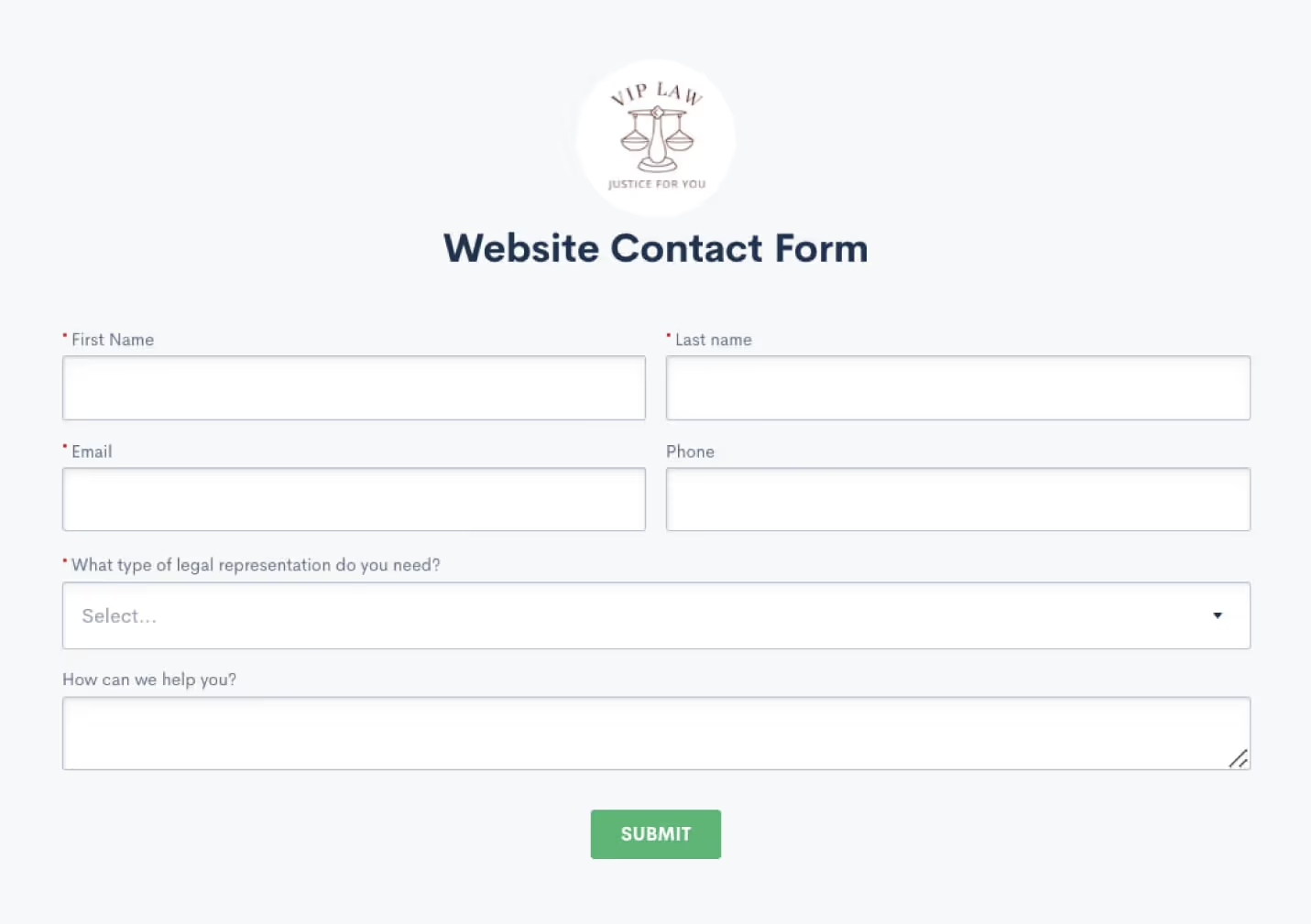
Automated client intake technology provides client intake templates that allow firms to customize their intake form based on specific needs and practice areas. By only asking relevant questions, they can tailor a client’s experience based on how they answer.
How do I make an intake form?
You can manually create an intake form, or you can lighten your load—and optimize your clients’ experience—with form automation solutions and workflows personalized to your firm’s areas of practice or types of cases.The more details that are requested on an intake form, the better a lawyer can qualify a lead before setting an appointment. Lawmatics client intake software allows users to build customized templates that can be reworked for each practice area and inputted directly into the law firm’s database, making the process faster and less error-prone. With Lawmatics, your firm will be able to:
- Build custom intake forms for clients.
- Collect documents from your clients electronically.
- Enable clients to access your calendar to schedule meetings.
- Eliminate lengthy back-and-forths with e-signature capability.
- Establish a clear and consistent intake process.
Are you ready to take the stress out of client intake with custom forms and a streamlined process? Sign up for a product demo today.







